Posts tagged as hellolamppost
Some of these Things are not like the others
2 December 2014Some of these Things are not like the others was a a talk I gave at Web Directions South, in Sydney, in 2014. It's the last variation of a talk I've been developing over 2014, about connected objects and, specifically, about connected objects for shared and civic usage. I gave a version of this, entitled A Lamppost Is A Thing Too at Solid in the summer of 2014. This is the longest, most complete version of it, and so I've preserved it here, derived from the script I spoke from.
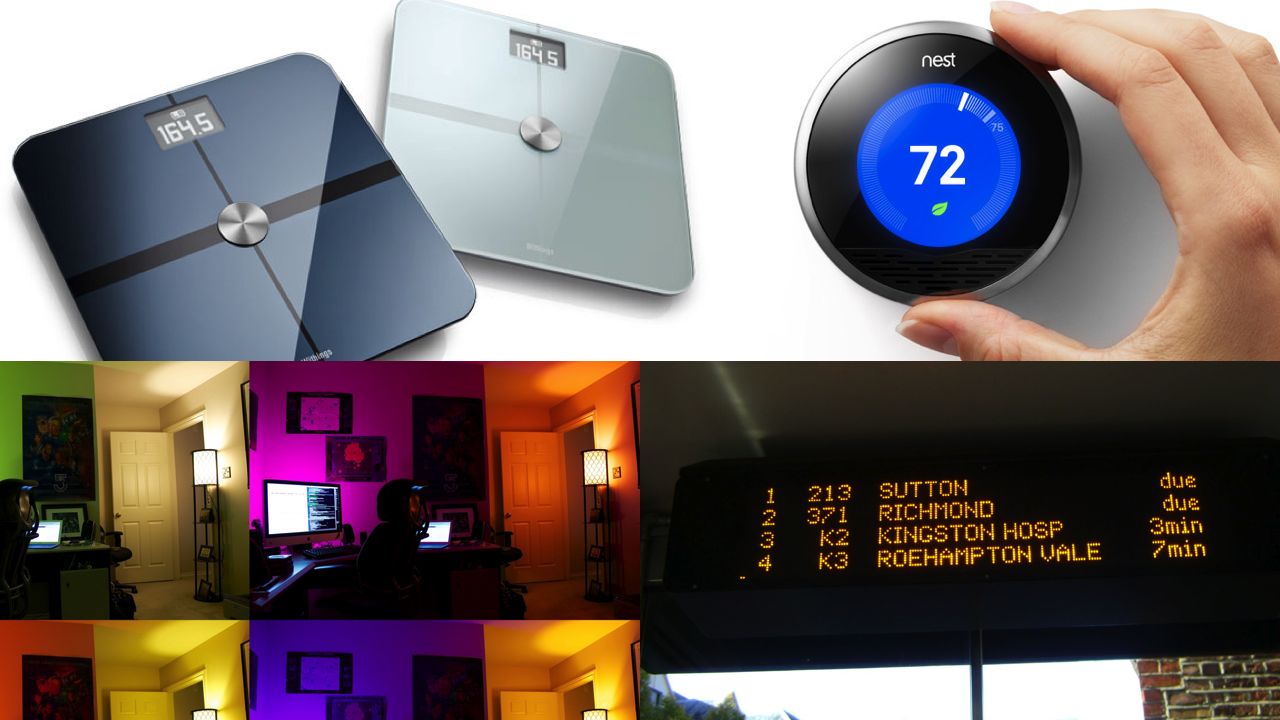
Scales that weigh you, analyse your BMI, the air quality, your pulse, and spit that data to the internet and to your cellphone via Wifi and Bluetooth.
A thermostat that adapts to your usage and, via Wifi, connects to the Internet so that you can control it from your phone, as well as see what it's up to.
A set of lightbulbs that can be set to any colour, scheduled and co-ordinated, all controlled from your phone via Wifi and shorter-range radio communications.
A bus stop that knows when buses are coming, via a data service and API.
That is, as you have probably guessed, a crude overview of the sort of objects – well, combinations of objects and services – that are being referred to as the 'Internet of Things'.
What I'm interested in today is what the word Thing in 'Internet of Things' means and can be; what happens when we go beyond some particular assumptions about what Things are.
Staring at those words written in front of me: well, I really don't like that phrase. It's so strange.
It others the Things – from the network they're on, and also from their users. Are they on a different network? Their own private internet? Not really. The point is how they co-exist alongside all other agents on the Actual Internet. I tend to use – and might well use in this talk, the phrase connected objects to mean exactly the same thing (and to make myself less uncomfortable).
Regardless, I think the same holds true: what can those objects be? And are there different models for what they can be – different patterns of usage? I think that there are, and I think a particular set of uses are under-represented. So today, through a variety of projects, I'd like to paraphrase Sesame Street, and consider that some of these things are not like the others.
I'd like to look at why they're different, and what the others can learn from them.
To explain why they're not, I'd like to show you a project from last year that I worked on, that explored what it'd be like to be in a city where many, many objects – a city's street furniture – were connected.
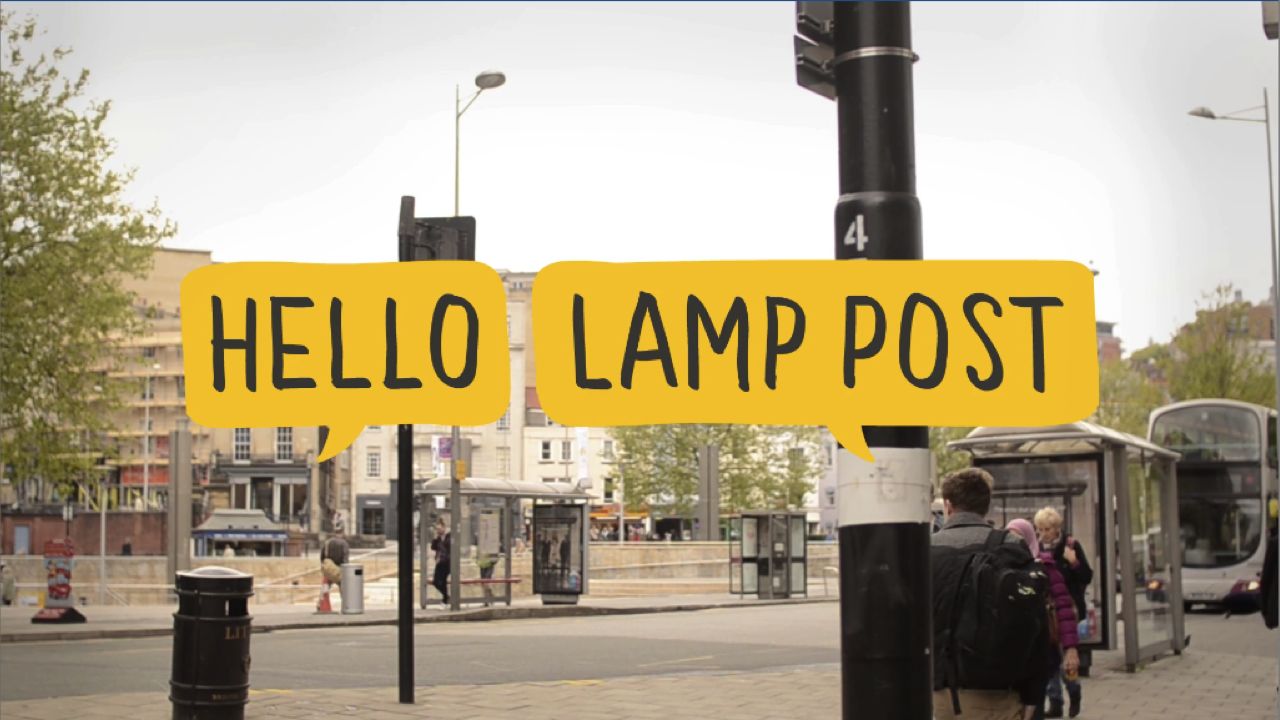
Hello Lamp Post was a collaborative project by PAN Studio, myself, and Gyorgy Galik. We entered it as a pitch for the inaugural Playable City competition, organised by Watershed, the Bristol arts organisation. We won the award, and the final project ran last summer for two months – from July to early September 2013
This year, it was nominated in the Digital category of Designs of the Year, at the Design Museum in London.
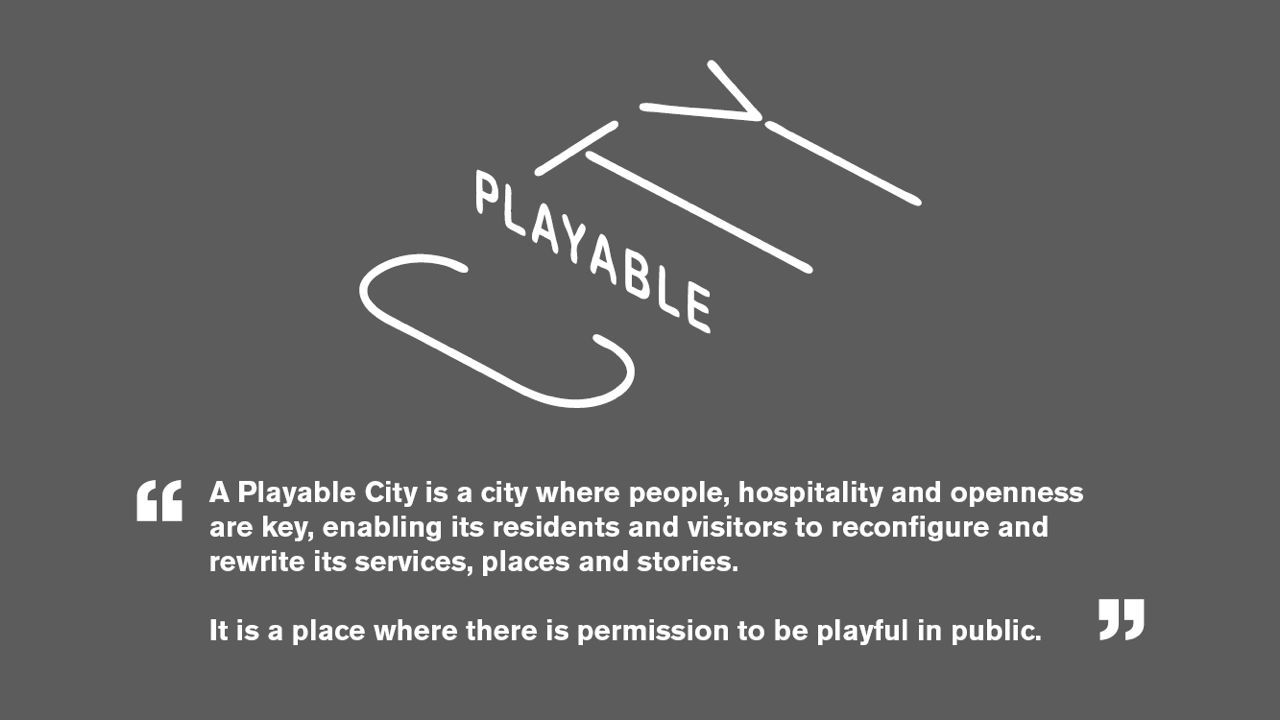
Watershed explained their concept of a Playable City thus:
A Playable City is a city where people, hospitality and openness are key, enabling its residents and visitors to reconfigure and rewrite its services, places and stories.
It is a place where there is permission to be playful in public.
I really like that quotation.
If the city is a platform – well, then, you ought to be free to play with that platform, wire and connect it as you see fit.
The Situationists, in sixties Paris, said sous les pavés, la plage – underneath the paving stones, the beach.
Well, the Playable City is a city built on the beach, not the paving stones above it. This is human, playful, gentle; very much the opposite of ideals about clarity, accuracy, integration, efficiency and refinement – all ideals that emerge in the prevailing rhetoric around "Smart Cities".
"Smart City": a phrase as divisive and, roughly innacurate, as "internet of things".
The designer Adam Greenfield has spoken of his preference for the description Networked City over the capital-S capital-C Smart City. He described the networked city as being made of
declarative actors and objects/spaces that have their own networked identities and shadows
"Smart City" is a marketing notion, wrapped around off-the-shelf, large-scale packages to be deployed onto urban environment and infrastructure. As Adam said at FutureEverything in Manchester this year – it's the 'imposition of technologies on people'.
What's more important is to consider all the discrete moving parts, the small pieces loosely joined, and how they fit together: networked systems, objects, and actors, interacting with one another at a distance, over APIs, legislature, process. These are all interfaces for the city. They're not all digital technology, either – they're frequently transitions between state, the digital communicating with the human, or the physical, or the abstract, and vice versa.
Cities are made of many different things, in many states, and digital technology's role shouldn't just be to bridge between all those states and the digital – but also to link things of one state to another.
I have some prior art when it comes to taking inanimate urban objects and turning them into networked actors. And, in the example I'll show you, you'll see digital technology bridging the physical to the human.
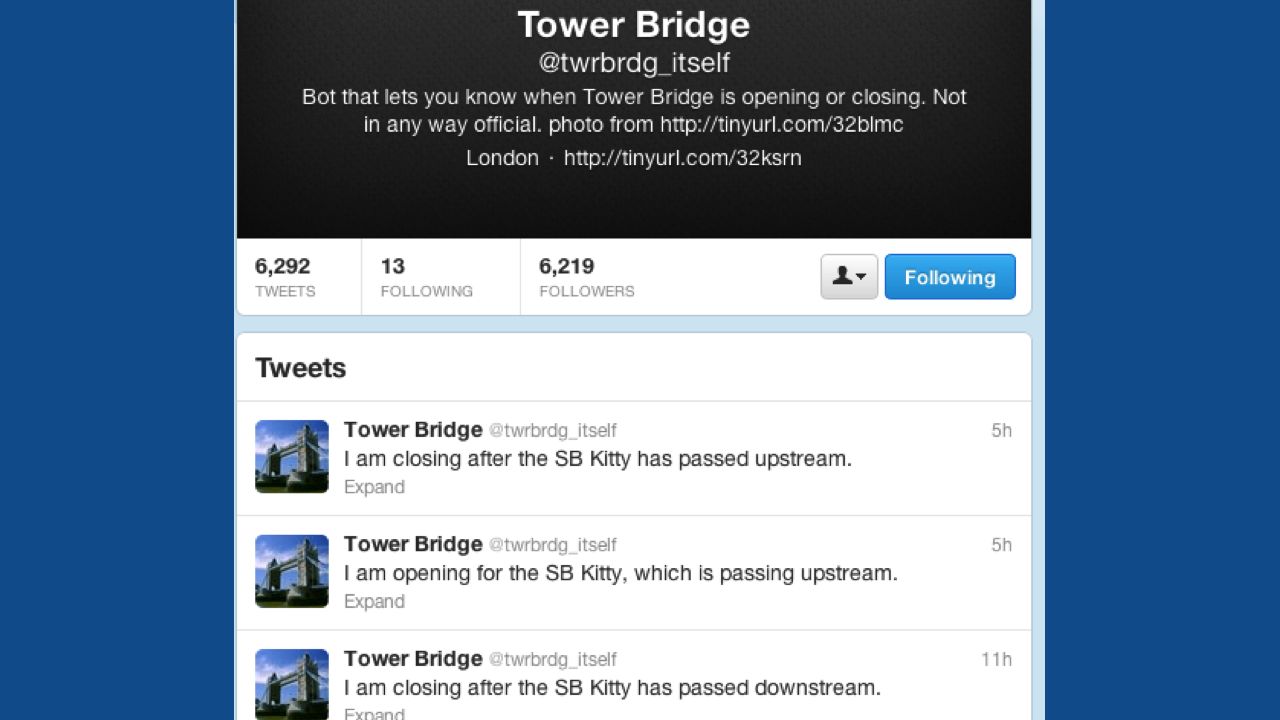
This is the first Thing (with a capital T) I put on the Internet.
In 2008, I worked near Tower Bridge in London, and I built this Twitter bot. You might have seen it before. It's really simple: it lets you know when the bridge is opening and closing, and for what vessel. I built it because it was there. The data's all publicly available, for free, and I had the technology to join the two.
I wanted to see what it'd feel like to have this information on Twitter for me and others – to have this object behaving as if it was just another one of us, bleating about what we were doing.
By taking this piece of infrastructure and mapping its behaviour onto a new platform (or rather, a stack of platforms – Twitter, the web, the network) – I was reminded that the city itself was already a platform. Not a hierarchical one: a city is a big jumble of services, almost like Unix. A Network of sorts.
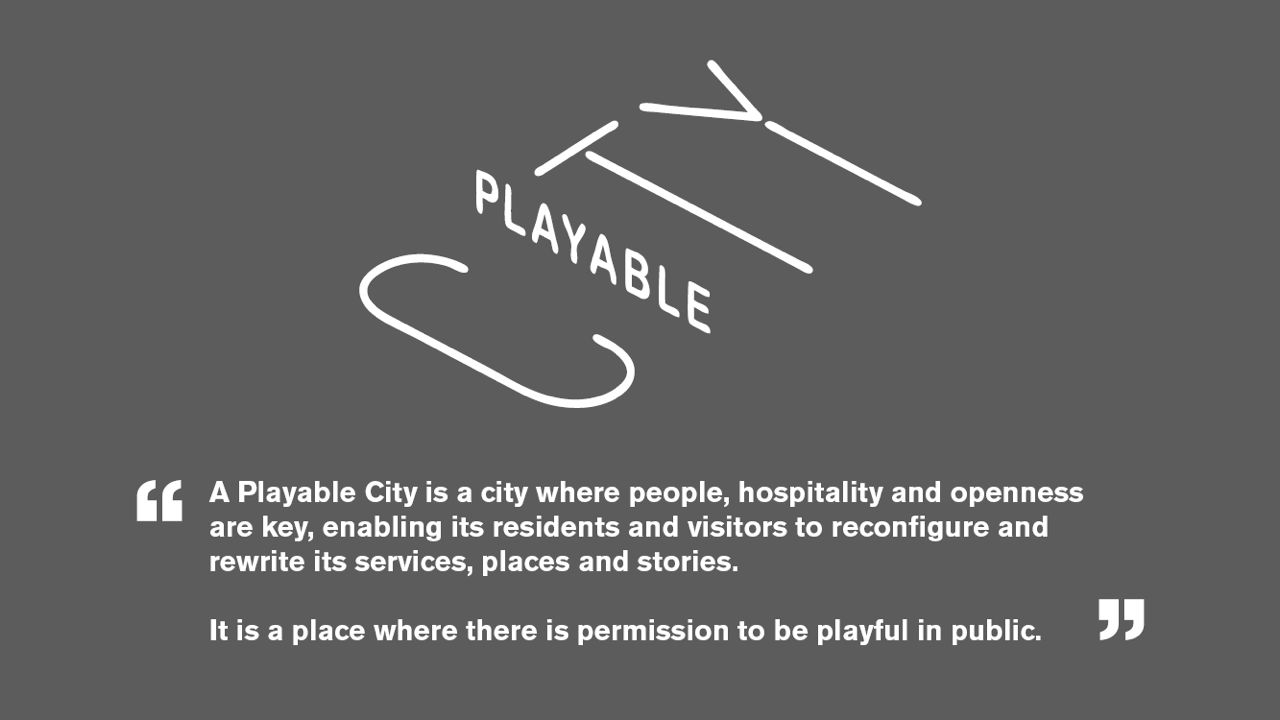
We very much wanted our Playable City to be an antithesis of the Smart City.
For starters, we wanted to use as much of what was already present as possible. The city is a surface – a platform – to build upon, and it already has many layers – the physical above and below ground, the legal, many digital representations. Adding another one felt ephemeral, temporary: wouldn't it be more relevant to show that Bristol was already playable? To use all those existing components within the city, and find a way to draw them together?
We would embrace the existing platform.
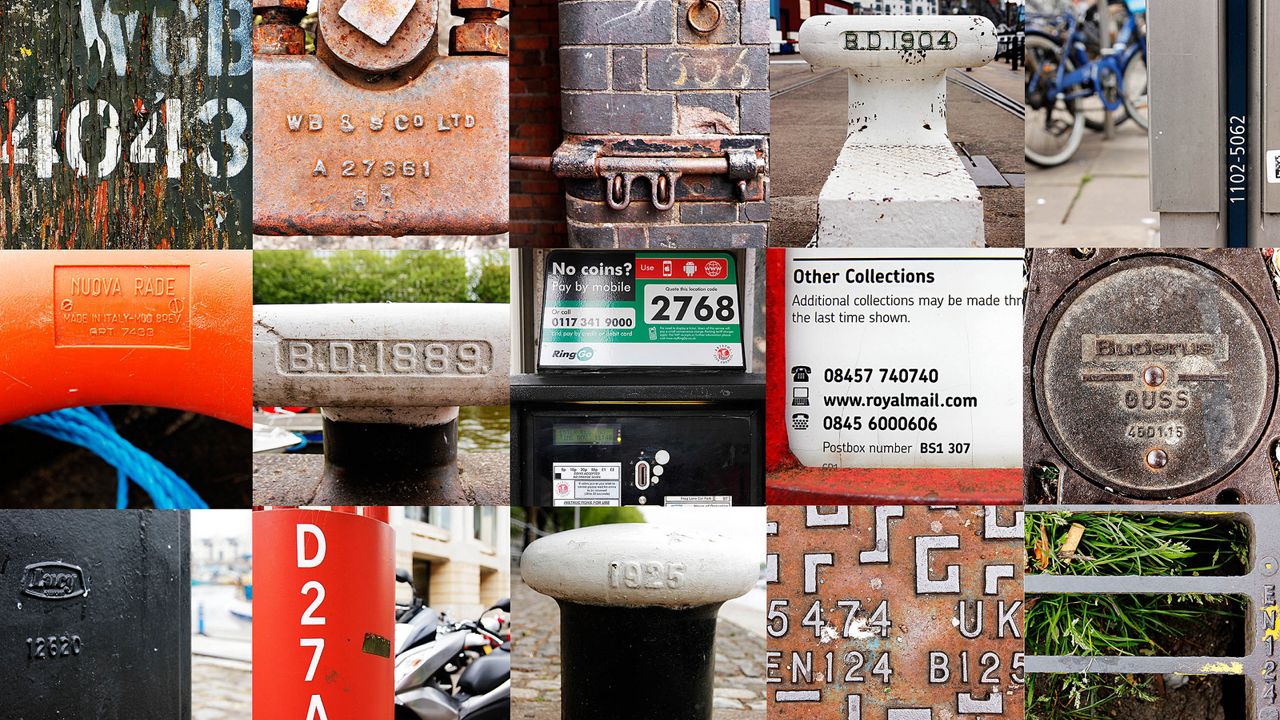
We spent a lot of time scouring the city for opportunities. We thought it would be interesting for the street furniture you see in a city – lampposts, postboxes, bus stops, cranes, bridges – to be intervention points. That way, we could use the existing infrastructure for our own purposes. But we'd need to find a way of interacting with them – of identifying them.
And then we noticed that a lot of street furniture has unique reference/maintenance labels.
We'd turn all these objects into the networked Actors in our playable city. They'd be participants to interact with, to see the city through a new lens with. Just like I'd done earlier with Tower Bridge, we'd find a way to bring them to life that was meaningful but without necessarily installing technology in them: a reminder how many of the actors in our cities are not necessarily people.
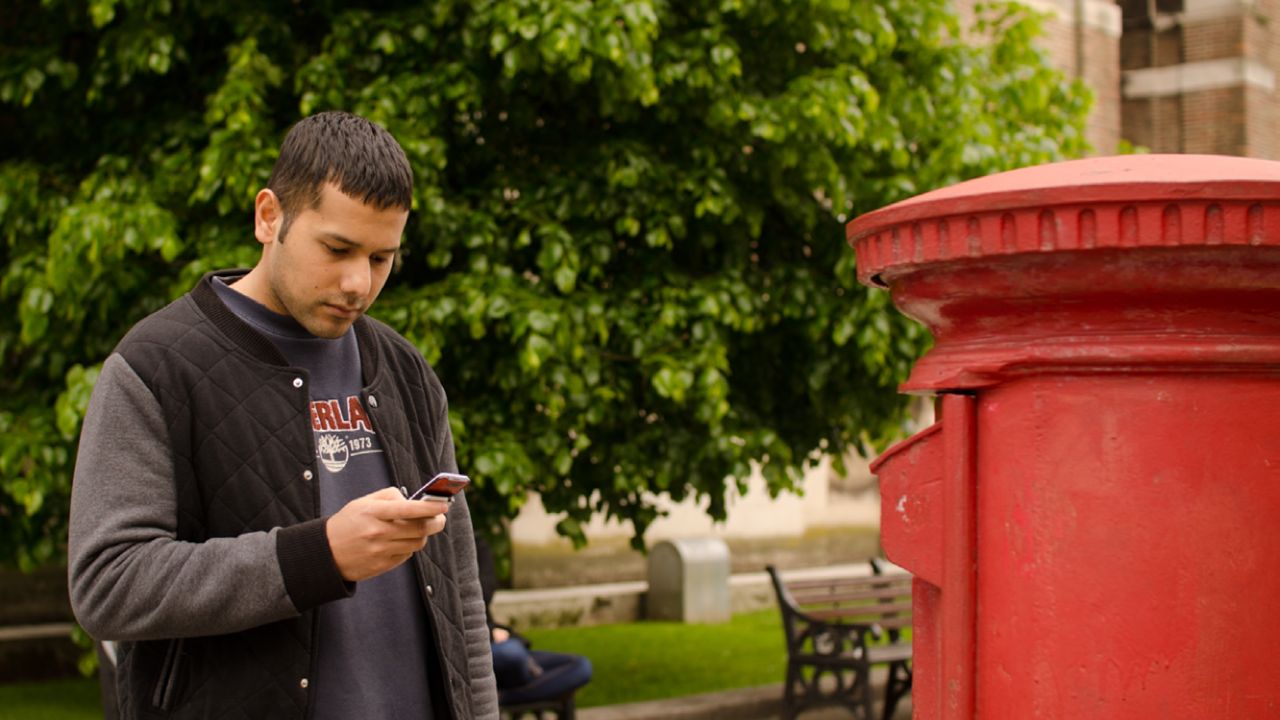
Although we were manipulating the objects within a city, we wanted to reminder players and participants that ultimately, a city is made of citizens. So Hello Lamp Post would also highlight the human element within the city.
We kept coming back to the idea of the city as a physical diary. We discussed a lot, from an early point in the project, how memory is so often inextricably linked with place. The city becomes a map of your memories there, all the good times and the bad mapped onto bars, streets, bus-stops that you sat in waiting for the last bus after a terrible evening. It's all overlaid in this spatial layer.
We wanted to help other people to see this way, by sharing past experiences and stories with each other.
And, crucially we wanted to do that for the most people, at the largest scale. The city is a platform with a huge potential audience, and to make a truly Playable City, we'd have to engage as many of them as possible.
Firstly, that meant making it super-accessible. An app for a smartphone might be cool and have GPS and that, but it limits your audience; we wanted a more diverse audience. Children often have cheaper PAYG devices; when we made Hello Lamp Post, these were rarely fully-featured smartphones; they were usually 'featurephones', perhaps with a keyboard in the manner of a Blackberry. Older citizens were often using the most basic Nokia or equivalent that their children have bought for them.
They weren't going to be core consumers for a GPS-based app.
By contrast, everybody understands SMS – every mobile phone has SMS. It's relatively simple to implement now, too: Twilio does the legwork for us, turning simple HTTP POSTs into SMS messages. Superficially unexciting technology made super-simple by web-based services.
And everybody, it turned out, quickly cottons on to the idea that any code, on any object, will do to identify it.
Those codes are much more tangible than GPS and quite commonplace. You wouldn't need a smartphone to join in, because we'd locate you by you telling us where you are. Which seems obvious, when you think about it.
At the time, I jokingly said that the Smart City uses technology and systems to work out what its citizens are doing, and the Playable City would just ask you how you are.
What we ended up, after all this, with was a playful experience where you could text message street furniture, hold a dialogue with it, and find out what other people had been saying.
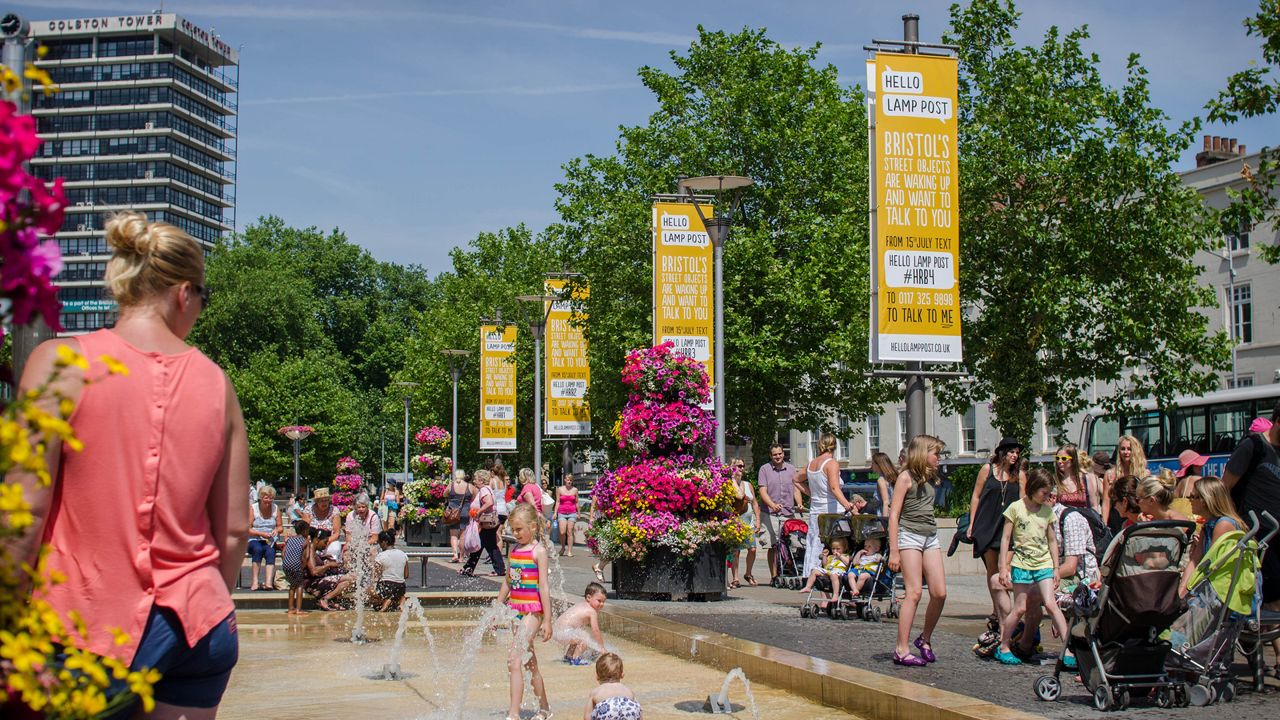
To induct people into the idea, we needed to make it legible – it's a fundamentally invisible system otherwise. Watershed helped us with a physical advertising campaign. Objects like the poles in the image above were our hero objects: the banners hanging from them told you how to talk to the object they hung from, giving you the entire instructions on the poster. "
Text hello post #code to number". It was super-satisfying that the posters could all be the entire user manual for the game. You do what they said, and off you go: you were talking to a lamppost, or a bridge, or a crane, or one of these poles down near the waterside.The majority of players interacted with these objects first – but many would then go on to play with other objects in the city, once they'd understood it. It helped give the invisible system form, helped them understand the breadth of objects that were part of it.
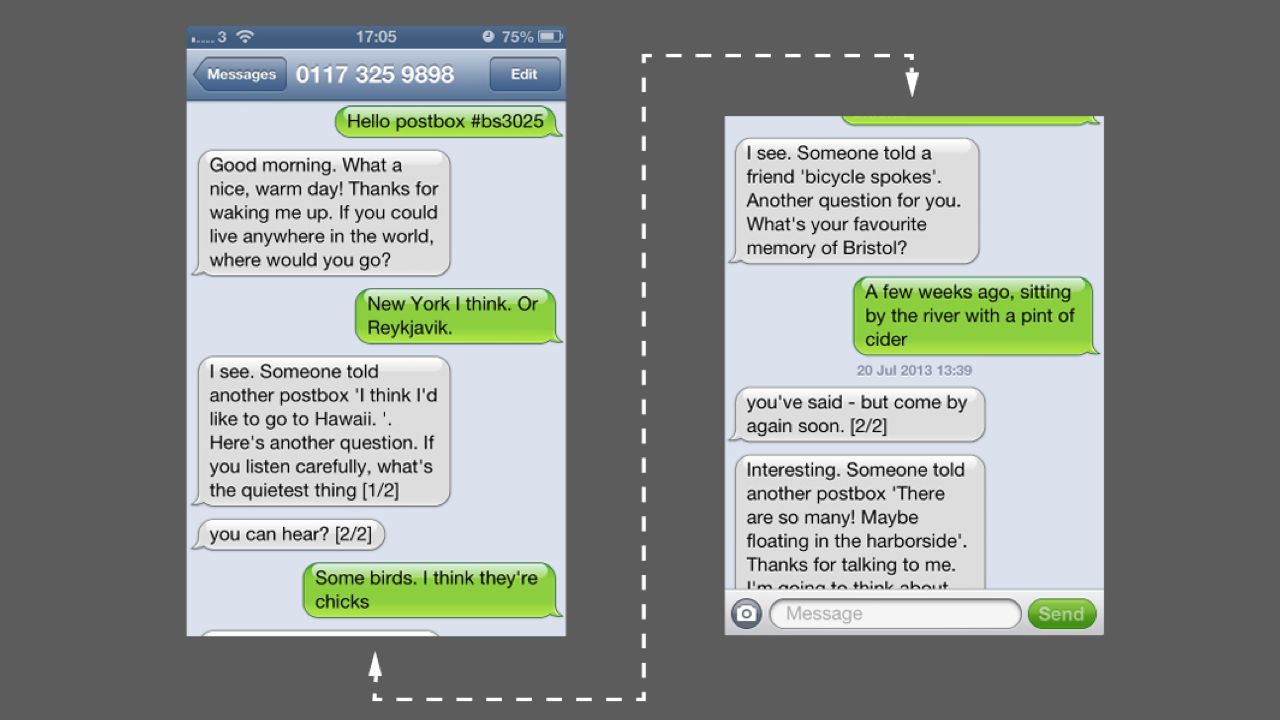
I suppose I'd better show you what a conversation looked like.
Here, you can see what a conversation looks like. I greet the postbox, and it asks me a few questions, some of which might be particularly "postboxy". (Postboxes are particularly interested in travel, for instance). I give it some answers, and it tells me what other people have told it, or things like it, or just other objects. You can see it also knows what time it is, roughly, and what the weather is. And, right at the end, you can see an exciting side-effect of SMS: we split a message longer than 160 characters into two messages, and send them, but that's no guarantee they'll arrive in order! Hence why we numbered the messages. (Twilio now supports concatenated 'long messages', but at the time we had to build it ourselves).
We were creating a ritual, about talking to street furniture. As you talked to the same object over time, it'd become more friendly, more intimate. Other, brother-and-sister objects would know what you'd said to their compatriots.
The writing is careful – it's humane, it's playful, but it stops short of anthropomorphism. The objects don't pretend to have full blown personalities. They don't change their mood. They know about thing you'd probably expect them to know about: the weather and time of day, which seems reasonable, and they ask you questions and tell you other responses, but they don't pretend to have feelings.
By engaging in our little playful intervention, we hoped people might understand the other Bristols that exist for its other citizens. We hoped they'd begin to see the world differently – not just seeing all the street objects they might otherwise pass by, but also see all the perspectives they might not otherwise see. How did what a lamppost in a poorer area of town heard compare to its brothers and sisters on the waterfront? The same system worked everywhere, so perhaps it would expose similarities and differences across the city.
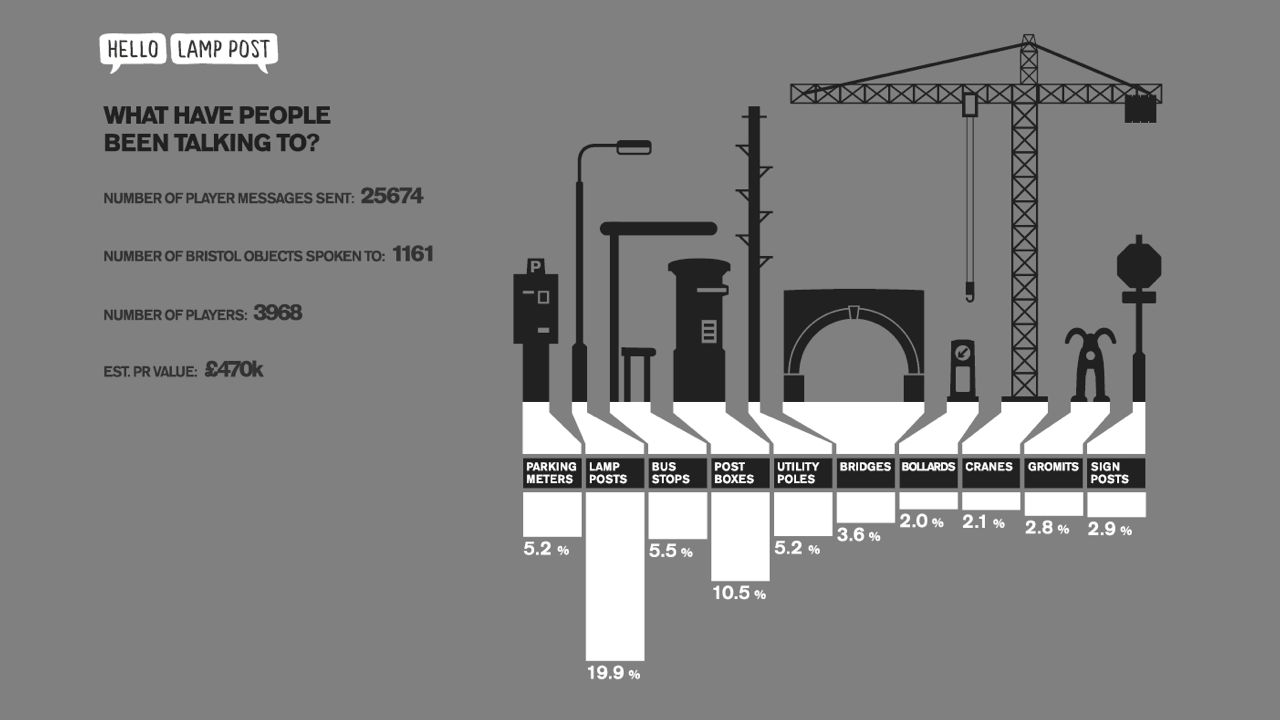
The project ran for two months last summer. We had just under 4000 players over the two month run, who collectively engaged in over 9500 conversations -speaking with over 1000 unique objects and ultimately sending 25000 messages our way.
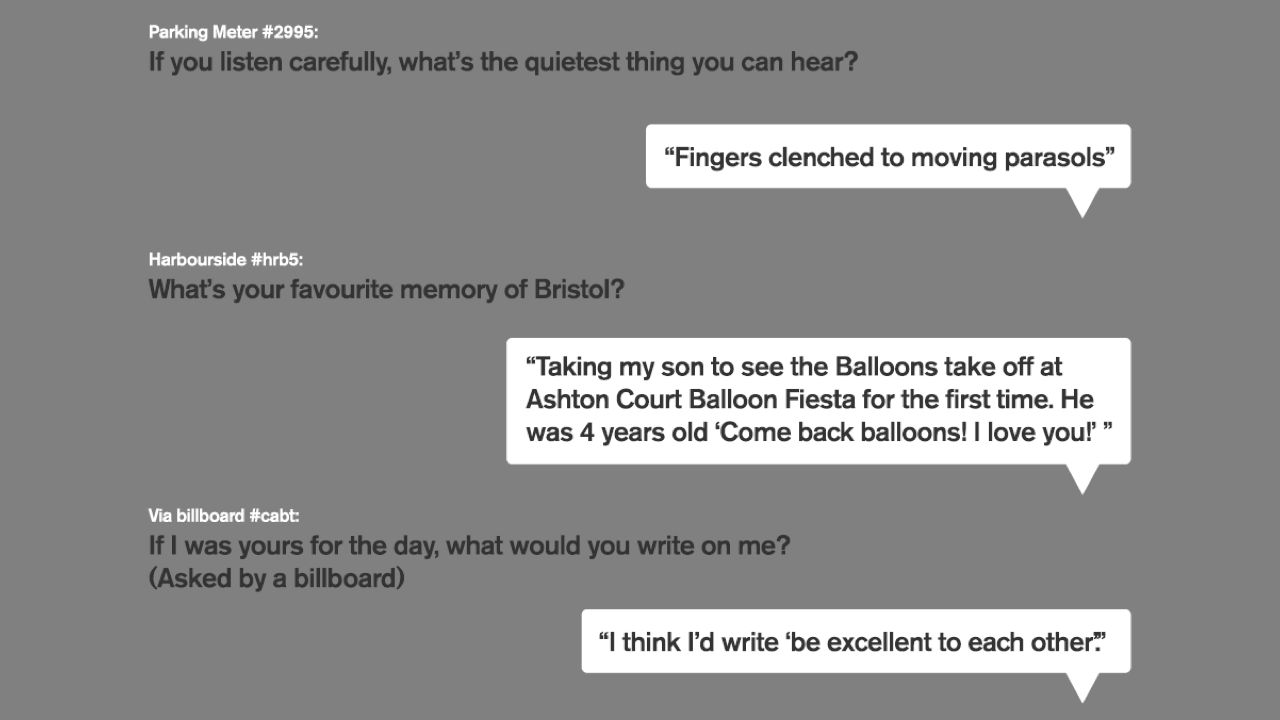
But what was most exciting was exactly what people were saying; what they were sharing about their particular Bristol with others; what those moments of ritual were creating. From the poetic, to the local, and the personal. And of course, because of the way the game worked, other people answering questions would see these via their phones.
And of course, the apt questions for particular objects led to particularly great answers.
Our hope – that this interaction would lead to these interesting perspectives – had been validated.
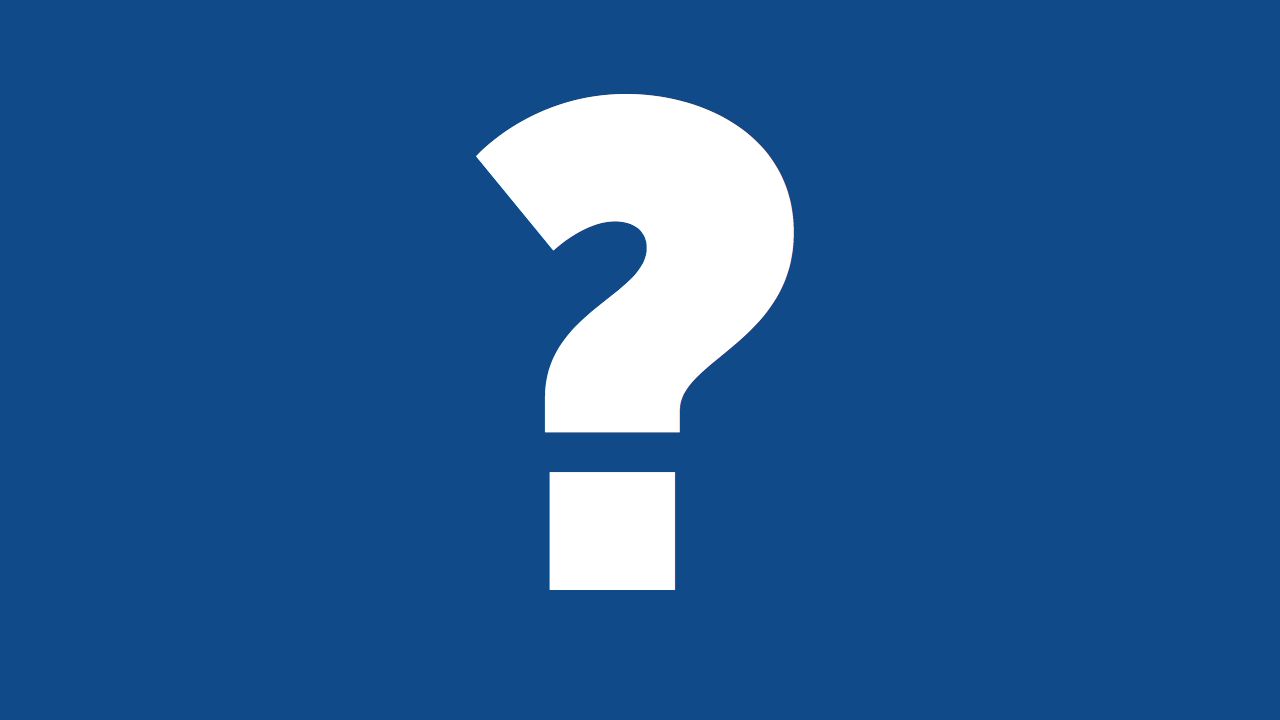
Why am I telling you about this playful toy, though? How is it relevant to the connected objects that I showed you earlier?
Well, I think it's important to consider the interactions and ideas here as part of the continuum of connected objects. Whilst we were clearly making something that had an element – just an element – of smoke and mirrors to it, these were real interactions that real people had, standing by objects in the environment around them.
Matt Webb described Hello Lamp Post in the Designs of the Year programme like this:
A poetic glimpse of what the future of user interaction will be in the 'internet of things', a technological vision where artefacts and physical environments are connected to the network'
Perhaps you can see an echo of his talk this morning in that. (Matt gave the opening Keynote at Web Directions South)
That is exactly what I hoped people would take away from it. Yes, there's a charming, playful interaction here – but there's also something else. There's a suggestion of a different way to interact with the city beyond apps and dashboards: something light, something conversational, something social.
And something civic: objects that are part of the network, but situated in the world, shared by their citizens.

So often, the focus on connected objects in popular media that we have right now is products like the Nest, the Hue, the Withings Scale: luxury objects that cost more than a non-connected alternative, targetting early adopters. Some of them are very well designed; some of them are very useful.
But they're for a small audience.
Connected Objects are not just white goods with a Wifi chip. They're objects that are made more useful through connectivity. That might be because they send data somewhere; it might be because they show it. It might be something that connects the data-representation of itself to the physical manifestation of it; it might be something that highlight the system it's a part of.
I think that the largest audience for connected objects, right now, is for civic objects with shared usage: the networked city.
That's why this bus stop isn't like the other Things.
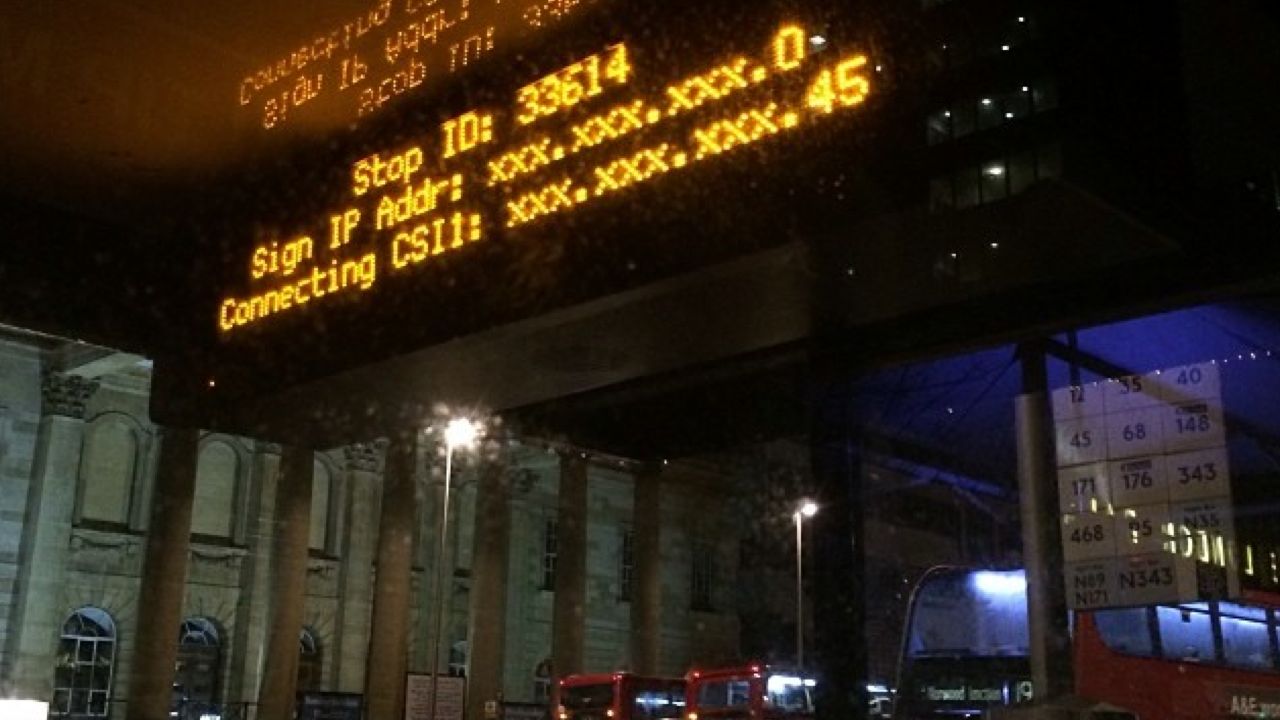
In fact, I would bet that the connected object that most people in London engage with, right now, is this: the LED display in a bus stop.
Nobody owns it; it's not a luxury item. It's a timetable made vastly more useful through network connectivity – and through the situating that data in the place it intersects with reality.
On the previous slide, you saw one of these when it's working. But, on the internet, everybody always loves taking this picture, of a dead bus stop showing you its IP settings – "isn't it funny that it's broken? Isn't it funny that it's just another crappy computer, like the one I have at home?" Really, though, we're taking a picture of precisely why it's an interesting object.
My Mum has a similar bus stop at the park and ride in the town where she lives. But it's not on the network: it just displays a fixed timetable like an animation. It is more than useless, really: it's a clock that's right twice a day. It feels strange to have to explain that where I live, those bus stops are not just accurate but alive.
This bus stop is part of Greenfield's Networked City: not a giant system, but separate objects with networked identities. The buses have GPS and a network connection to tell the system where they are; the system updates the displays as appropriate – and also the various public APIs it supplies to developers. These objects are part of larger systems, working together.
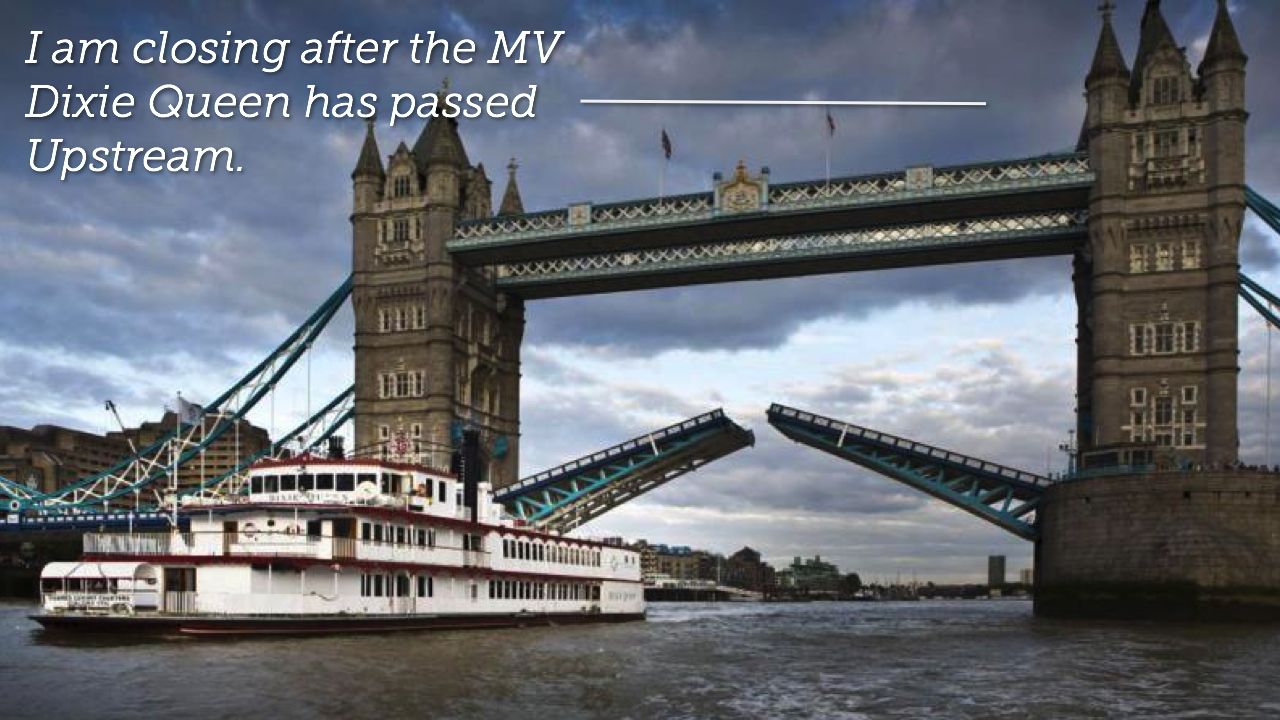
The Tower Bridge bot is another networked actor.
It's a bit different to the bus stop, though, and indicates an important aspect about these networked actors in the city: they can have a meaningful presence on the network without themselves being connected. Tower Bridge is not, I hate to say, tweeting the second its motors spin into action. I didn't install any hardware!
Instead: a server is tweeting when the timetable (another manifestation of Tower Bridge) says it's opening. To all extents and purposes, the data-representation and the object are mirrors.
(Hang on a second: are they? Well, they are to a certain number of significant figures. Whether you think that makes them the same or not is partly a personal decision, and also something we'll come back to. Anyhow.)
What makes it feel like it's the bridge itself tweeting, weirdly, is not the mechanics of how it works, but the fact it behaves like anyone else does on Twitter. It talks in the first person. That's what you do on Twitter. When I made it, the question Twitter prompted you with by its textarea was What are you doing? And you naturally answer that.
We all speak in first person on it; so if you're going to put devices, objects, buildings, or infrastructure on Twitter – surely it makes sense for them to do so too?
And that first person, present tense voice pulls an interesting cognitive trick: it suddenly feels like the object itself really is talking. Which leads to an interesting proposition around identity.
Namely, the idea that a representation in the mirrorworld can represent a particular real-world object isn't necessarily related to whether the data is coming from the object itself.
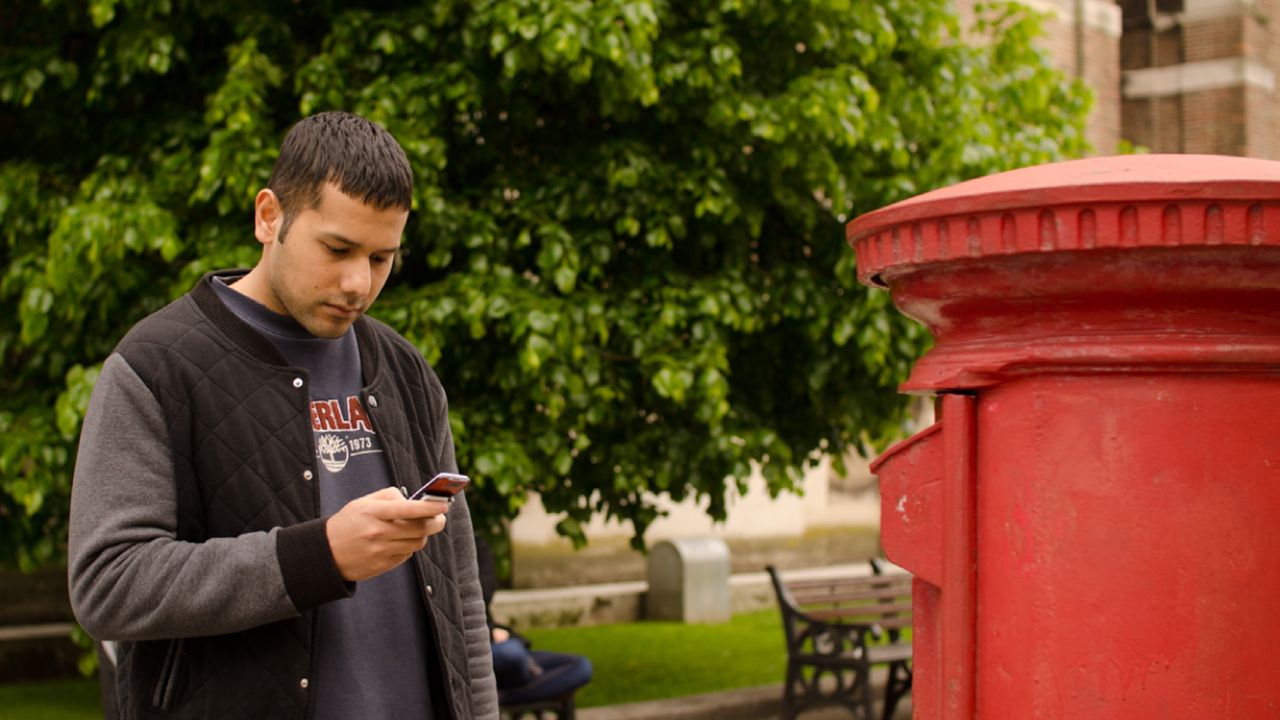
When we interact with Hello Lamppost, with Tower Bridge, we don't care that the object itself isn't connected to the network: it feels and behaves as if it is, and that's often enough.
Is that a lie? I don't think it is. With Hello Lamp Post, it was clear from the conceit that the objects were not talking – there was some kind of magic there. It just wasn't quite the magic you think. The magic was not entering every object in the city into a system: it was making the whole thing work for any object in the city. It's no surprise we talked a lot about cold reading – you know, the sort of techniques used by mentalists or psychics to tell you things about yourself – in the early stages of the project. Could we get the objects to say things that couldn't be wrong?
In our early playtests, the system didn't pull that off. It wasn't that one bit wasn't right: it was that the whole thing fell apart a bit. The tech didn't quite parse messages right; the tone of the dialogue wasn't quite right; sometimes, it made assumptions it shouldn't have, or it prompted for questions accidentally. (One thing we learned: only put any text in ending in a question mark if you want an answer to that question. Every time, as a conjection, an object said really? people would answer that, rather than the next question, and it all got messy.)
But we fixed all that. Sometimes, by simplification: making the format that you saw earlier, tightening up the options on offer, making sure the object would rather say nothing than say something that might be wrong. (Like true Brits, our objects only talk about the weather if it's especially wet/sunny/cold. If it's vaguely grey or maybe a little damp, they just don't bother saying anything). And the illusion suddenly tightened up.
Tower Bridge is a bit different though, hence why I asked you to think if you had a problem with the data-representation standing for the real thing. It feels realistic when you're on Twitter, that's for sure. But if you're standing next to it with your mobile phone in your hand, and you're looking at it, and Twitter says it's closed – when really it's 10 minutes late opening... how do you feel? Do you feel lied to? Or do you not care, because a talking bridge was always going to have some magic or deception in it somewhere and now you've find where the stack falls apart?
I'm OK with it, because it's figurative: it's existence is its meaning. Some people find it functionally useful – cabbies and cyclists have both told me they've used it as a tool – but they seem to have implicitly understood the abstration, the trade-offs at the heart of it. Which is interesting.
My point is: Sometimes, joined-up is as good as connected. But, in the space we've got to discuss this, I think it's important to note that if you're going to make an abstraction, smooth over some cracks: be sure to either be completely explicit about that, or, if they don't actually matter, consider creative, charming ways to paper over them in service of an illusion.
Importantly, though: if the abstraction really must be understood – usually an issue with serious, important service, don't paper over it.
But even if it's not serious, if breaking frame or the facade falling is a bad thing: you're going to have to work hard at perfecting that facade. We spent a long while on the polishing of Hello Lamp Post, making sure it would never fail in a catastrophic, frame-breaking way.
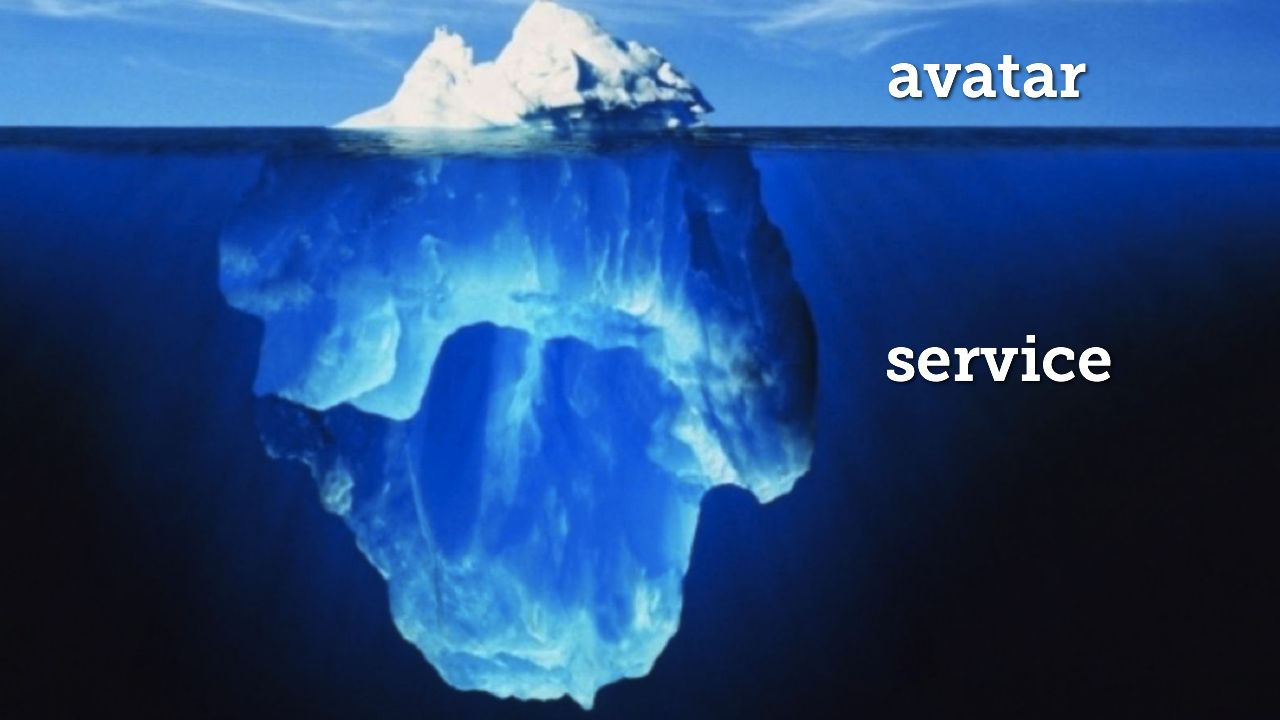
Earlier, I described the world of data as a mirror-world – a term I'm lifting from David Gelernter; this idea that there's another world that mirrors ours, reflecting it as information rather than reality. These connected objects manifest both in our world and inside that data-world. And our interactions with those connected objects reveal that data-world through the physical object.
Connected objects extend beyond themselves, like an iceberg, into the invisible. They are avatars of something larger than themselves.
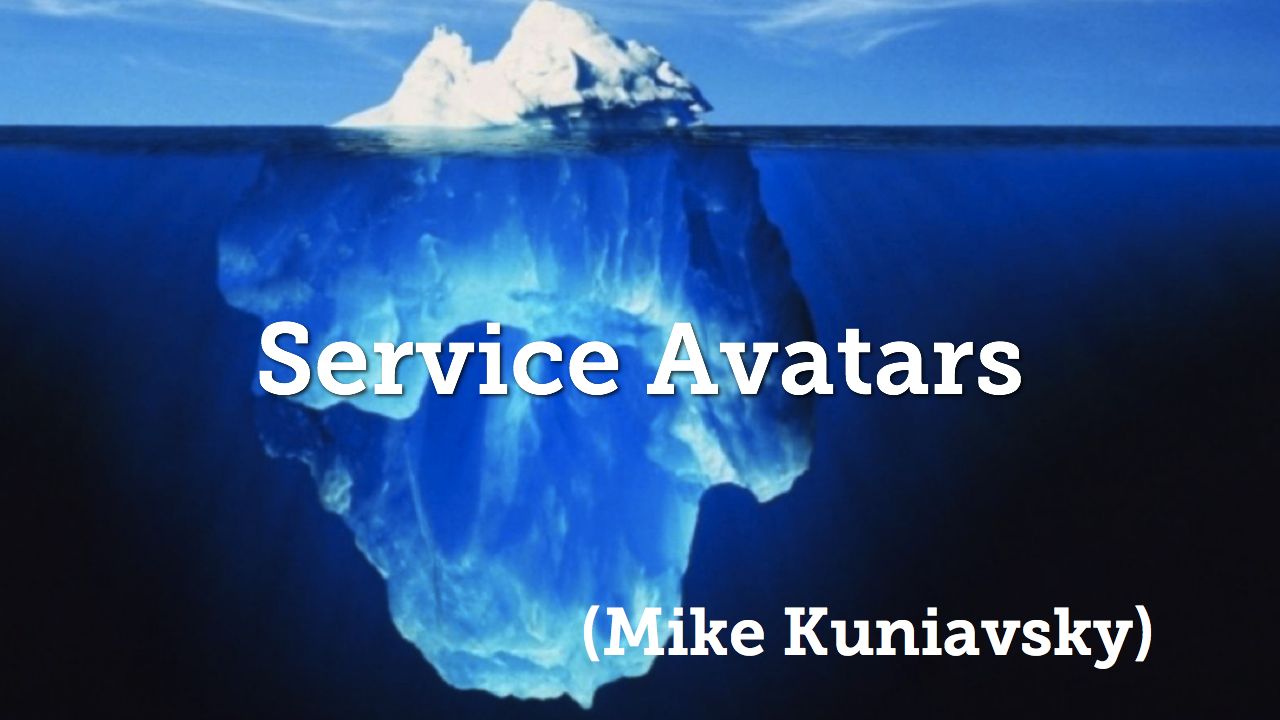
Mike Kuniavsky coined the term Service Avatar several years ago to describe the role connected objects take. Connected Objects, done right, are rarely just a device with a network connection: they're a material representation of a wider system.
This is why, say, I enjoy Instagram so much: it's a camera that also has my friends' photos in alongside mine. By placing upload and sharing into the camera itself, it stops being a camera and becomes a manifestation of that end-to-end service of take/share/browse/comment.
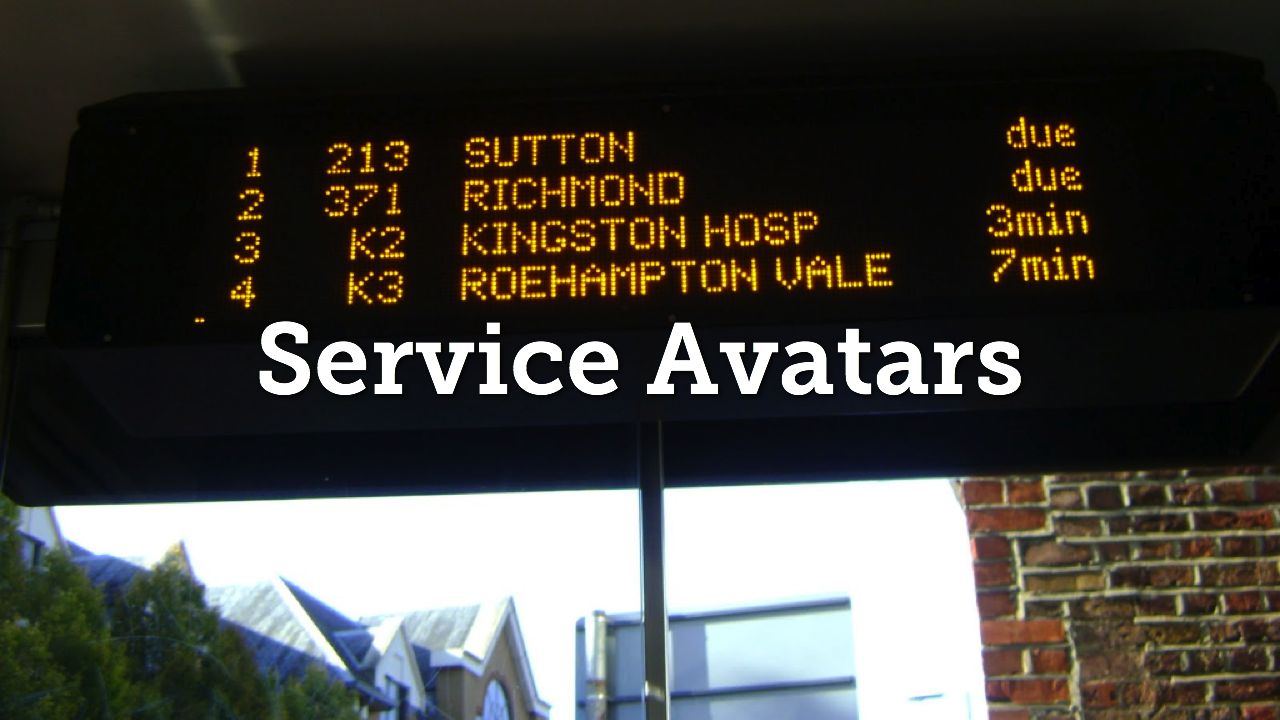
So going back to our bus stop again: the bus stop is a service avatar for TFL. Yes, it's giving you factual information: but it's also an avatar of the networked platform, the buses, the APIs, London Transit as a whole. It's synecdoche – the part standing for the whole – of London Transit.
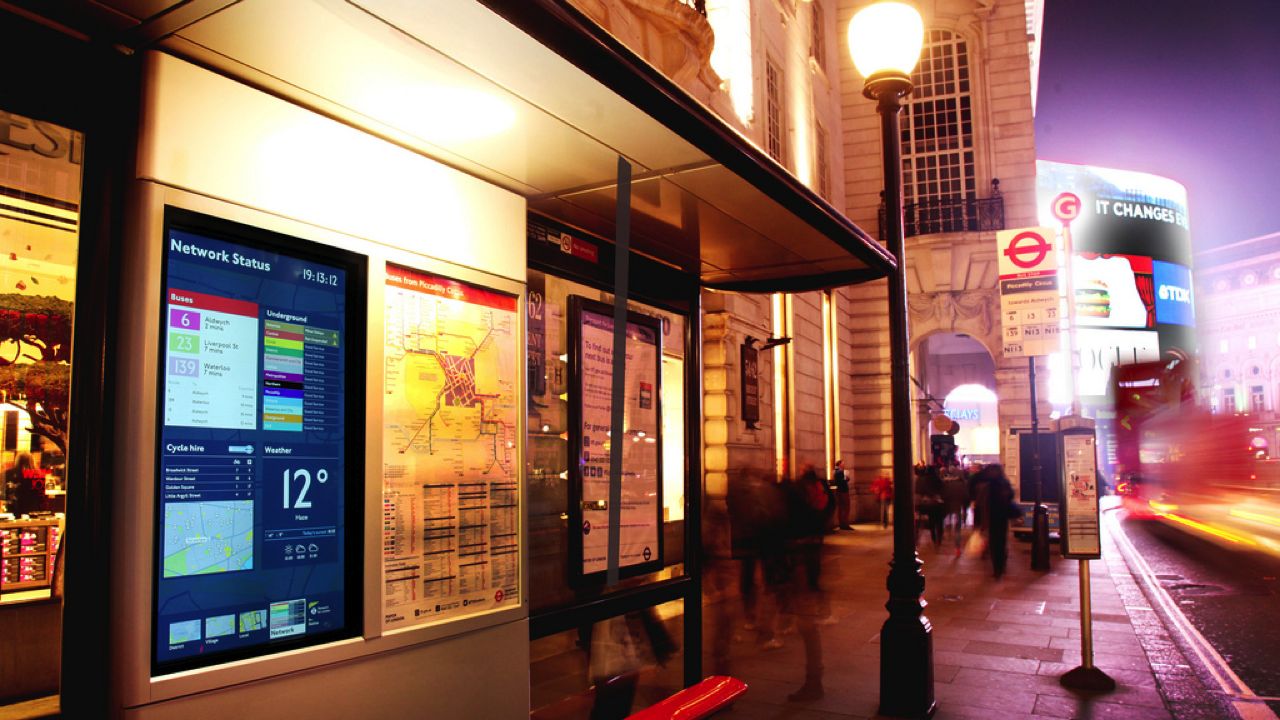
But it's very one-way. If it's an avatar for a whole service, why can't I talk back to it? The connected objects we see in the consumer space are personal – they give direct benefit to the user. Civic Connected Objects too need some kind of personal focus – it's not enough to just be a display for everyone, like this trial of a new realtime display in London (a collaboration between TFL and ClearChannel).
So what are the new interactions for civic connected objects that are personal, functional, and two-way?
Why not an email from a station I passed through earlier in the day to let me know it has severe delays, in case I'm going back that way tonight?
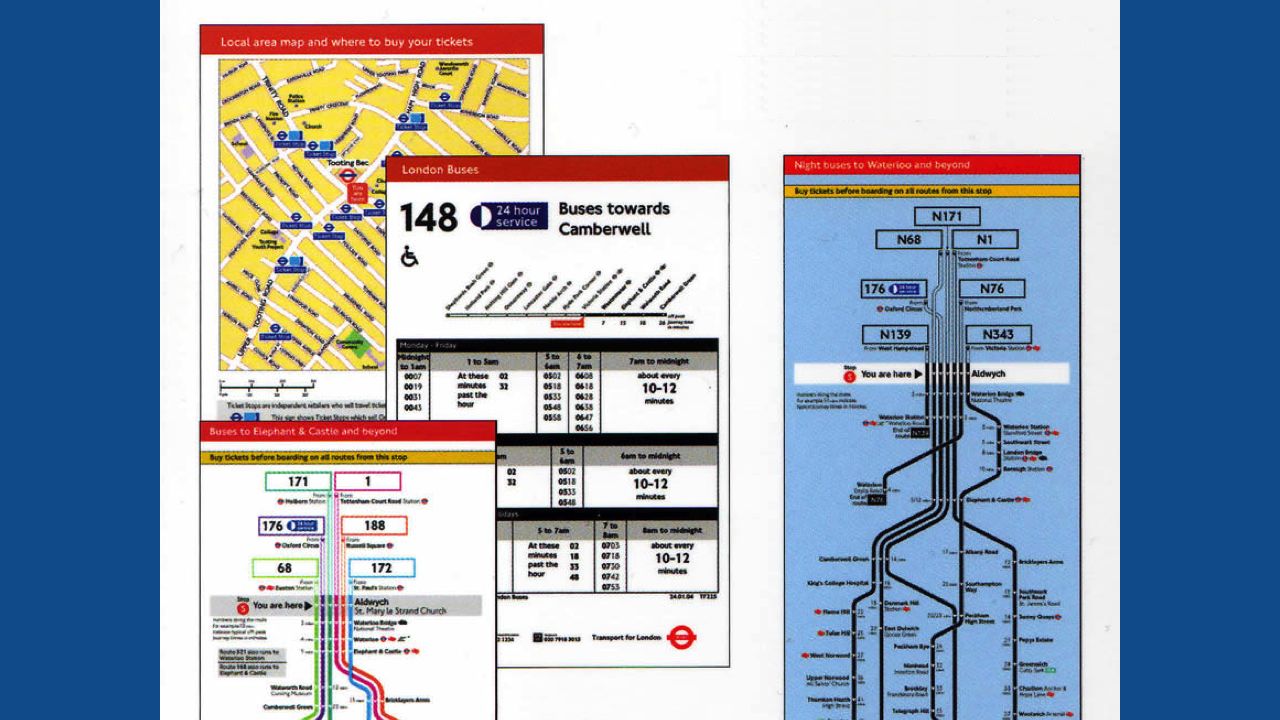
The bus stop only shows me a timetable for services from it. What if I wanted to know how to get from here to anywhere else? Why can't I just text it and find out? I don't want to tap on a big screen and show everyone else where I'm going.
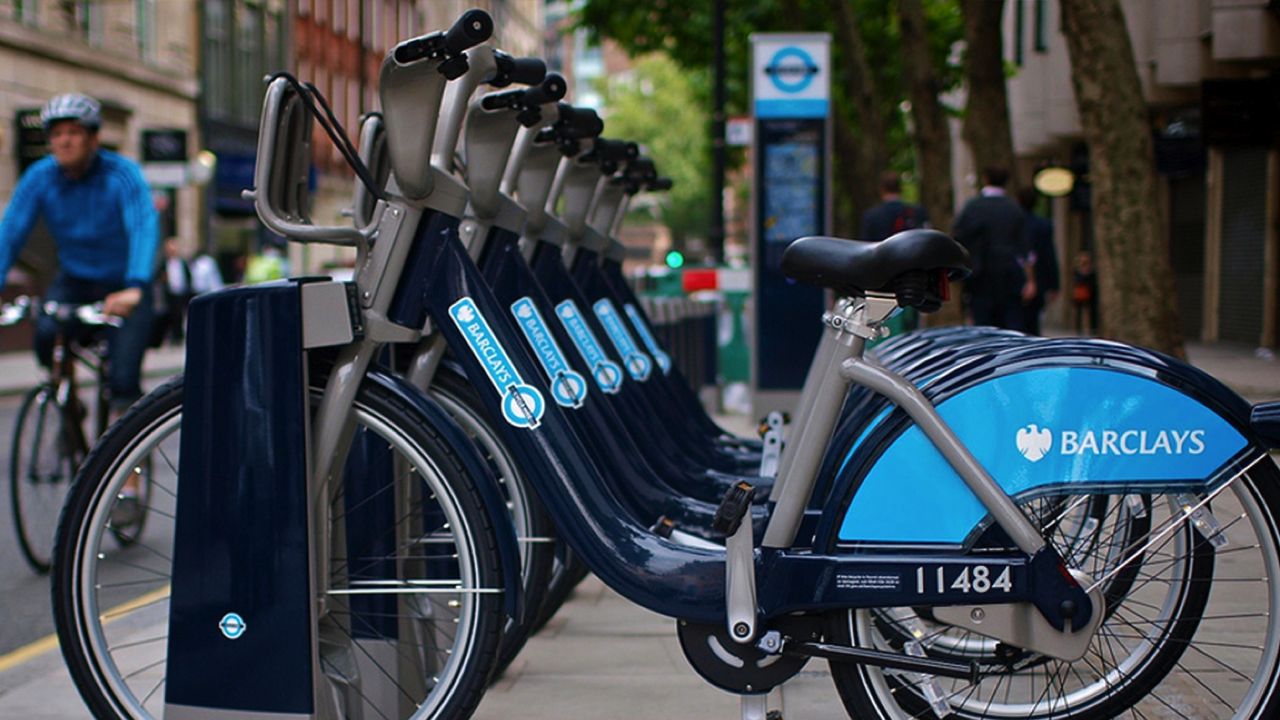
Why doesn't my hire bike know its way home – to the nearest empty bike rack – even if I don't know where that is? What would that object be like if it was connected, and illustrating the data that TFL already makes public?
I decided to find out.
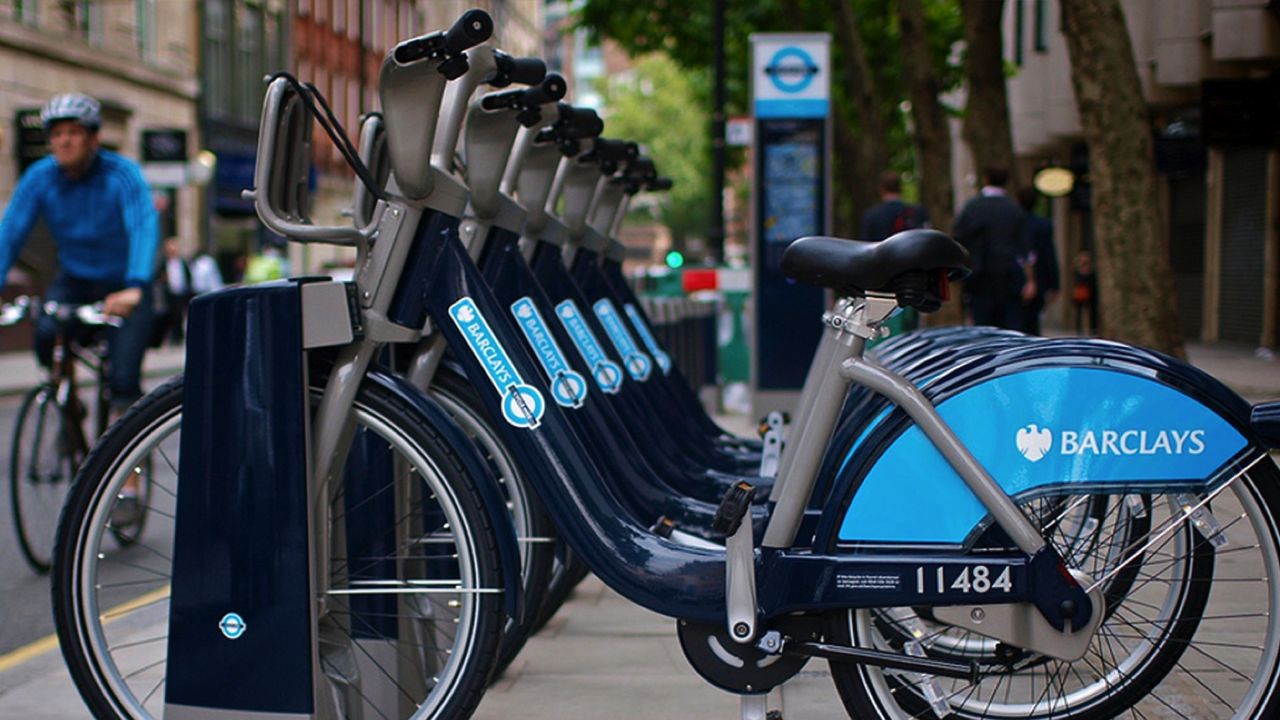
A common pattern of use for London's hire bikes it to pick one up, ride it to wherever you're going – which you normally know the way to – and then pull out your smartphone and use one of the many apps that's out there – all using official TFL data – to find out where the nearest empty rack you can park in is.
That last component is a fairly critical part of the system for many users – it certainly improves it no end – but a smartphone feels like a very high barrier to entry for what is supposedly public transportation; transportation for everybody.
So what if we embedded that data in the object itself – turned it into an avatar for the service?
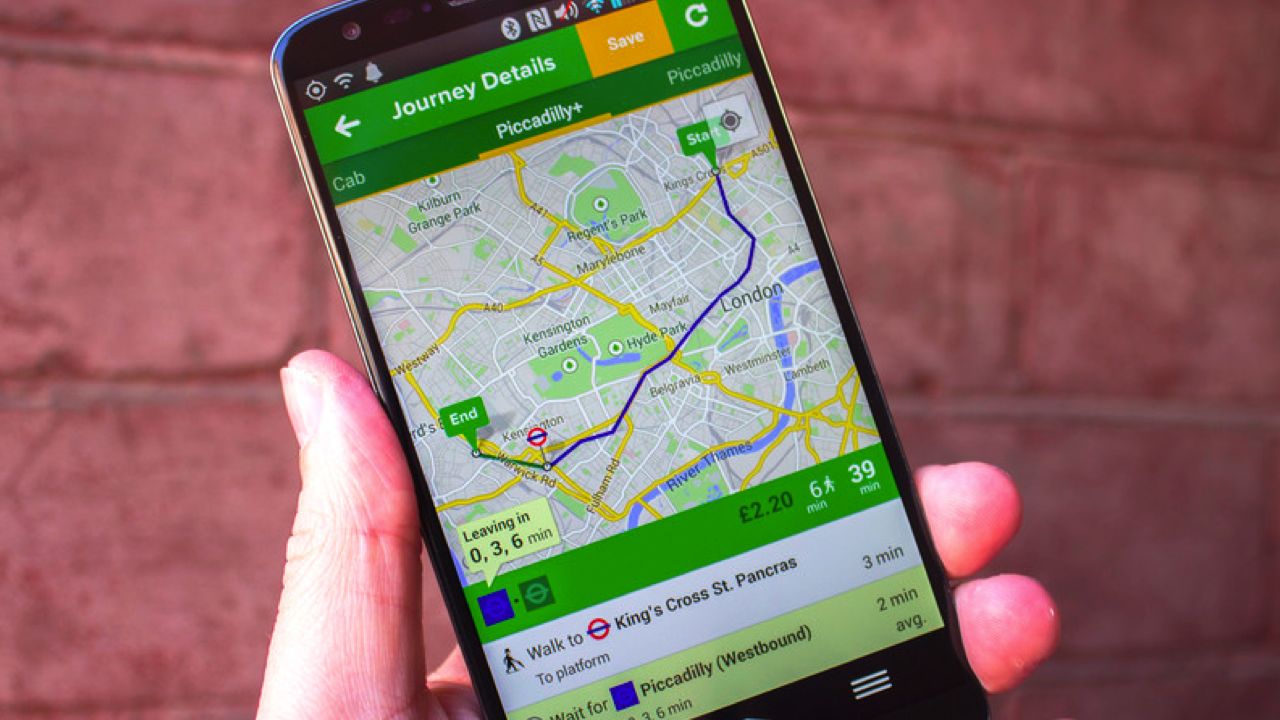
So to be blunt: What if a service like Citymapper wasn't in my £500 mobile phone, but in the city itself?
This is Columba. It's named for the genus of the pigeon – and chosen because pigeons are both a common sight in London, and good at finding their way home.
It's a compass for hire bikes, that always points towards the nearest empty station. The width of the indicator shows you how close you are.
When another station becomes nearer, it flashes green to let you know.
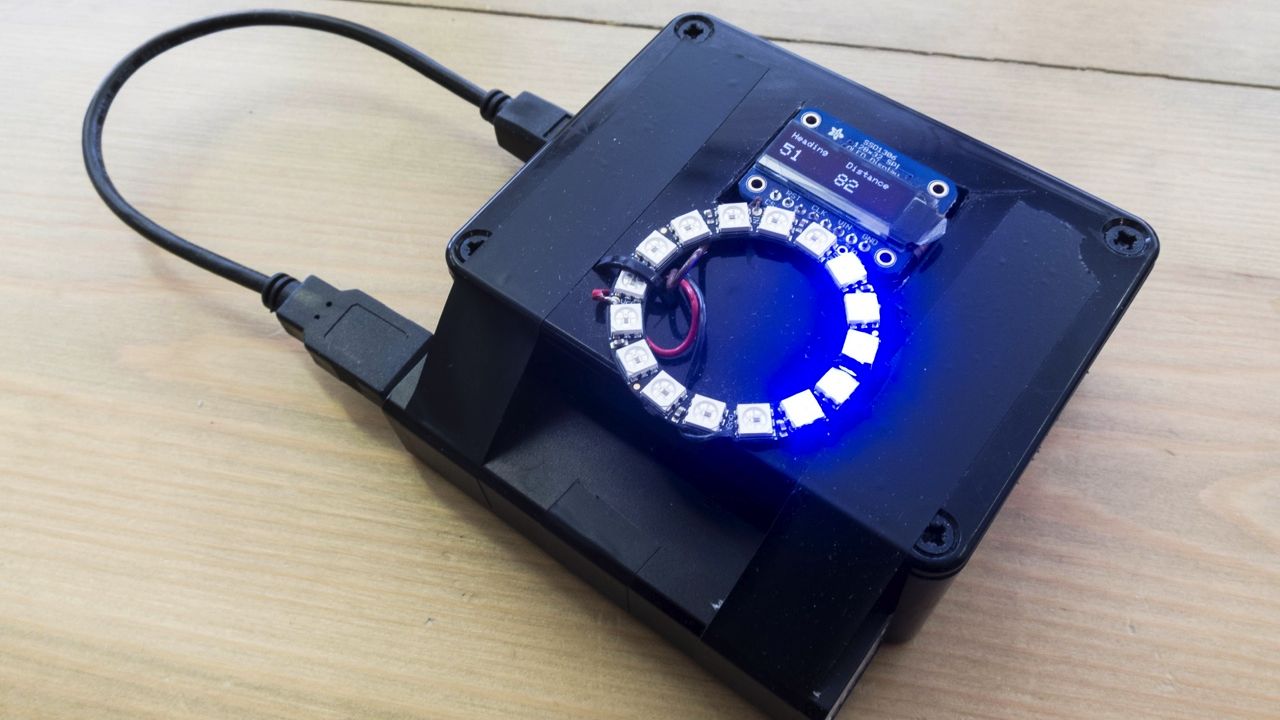
Let's talk about practice and craft, briefly. Columba is a simple prototype. I've described it previously as an experience prototype. What do I mean by that?
Its goal is to explore the idea, to understand the problem by holding it in your hand, and to demonstrate certain thoughts. It's not an object to sell (not that I'd want to – I'd want this built into a bike) and it's definitely not the way you'd build this thing for real. But it is definitely enough to understand what it feels like when the bike knows where it is; how it changes how you use the bike – and also enough to understand the grain of the materials involved.
I say this in a lot of talks, and it's a strand of thinking indebted to my time at Berg, but I'll say it again: technology is a material – a family of materials – like any other, and to understand how to make things with it, we need to manipulate it with our hands. We need to feel the grain of it. Just like the wood Columba is sitting on has a grain – along which it's much easier to manipulate it – well, so do programming languages like C or Python or Swift; so does technology like RS-232 or Wifi or 3G or Zigbee; so do data and interfaces like APIs. We need to understand those materials.
We don't understand materials – not really – by reading the manual. We read it, sure, just like we know the on-paper tolerances of a sheet of metal, or of an electronic component – but we still have to understand how that translates to the real world.
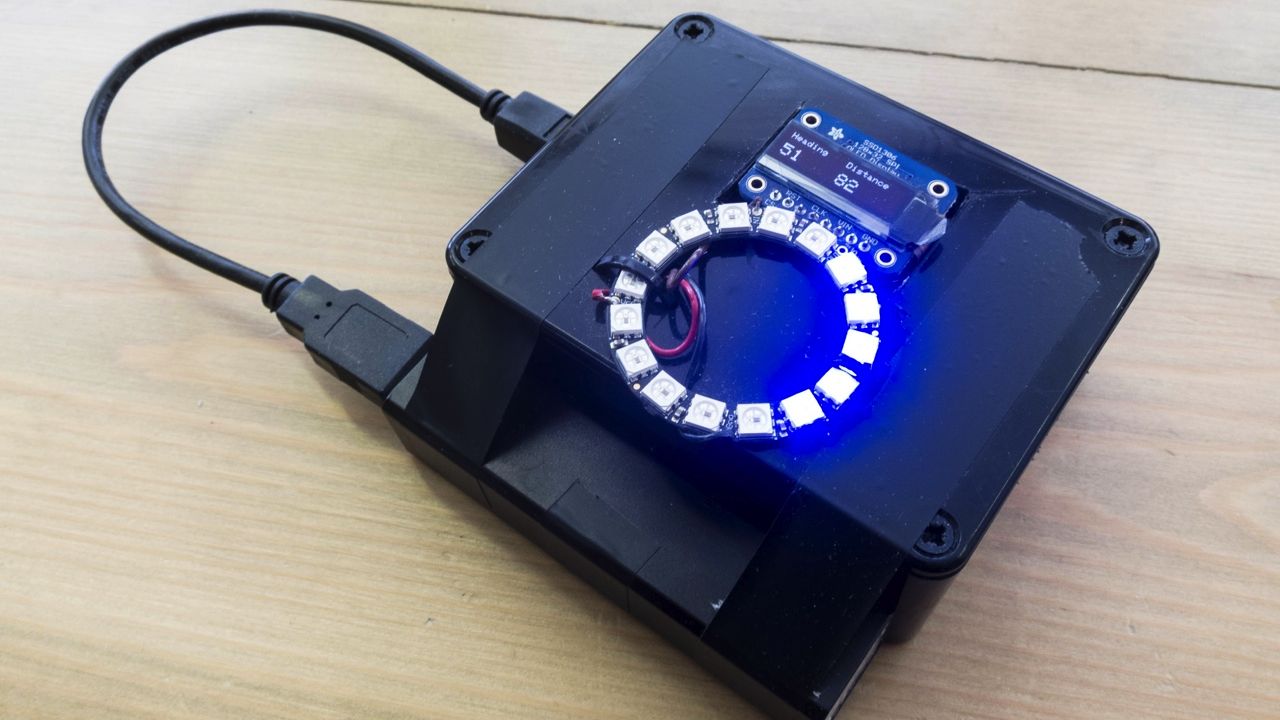
The way to understand a material is to hold it in your hands – and, usually, to find ways to sketch with it. In some ways, Columba is a physical sketch. It is constrained enough by real conditions to understand what those conditions mean. It's not just a fag-packet sketch, an idea tossed to the wind. I had to feel that grain to understand it, have a thing to show you.
The conditions in particular that I was exploring were making it self-contained; battery-powered; using 3G connectivity to update itself, from real data.
There's an earlier prototype that is a iPhone-specific web app. That was my prototype for understanding the data; later, it became the back-end for the physical version of Columba.
What did I learn from all this? For starters, It became clear that it probably shouldn't be always on. A button to interrogate it – as if you were asking the bike "where do you live?", rather than it constantly telling you – is much more empowering for the user and less distracting. You would get the information when you need it. It changes the interaction model to question and answer, rather than a stream of data.
I was reminded that the public data set is around 15-minutes out of date, which isn't a problem most of the time, but is at a mainstream station in rush hour.
I also remembered that I'm still not very good at riding bikes.
But: I also had it confirmed that the model of pointing in a vague direction and letting the human riding use their nous as to where to go is a good interaction pattern for cycling, and it doesn't feel, as a whole, an entirely outlandish experiment. I confirmed easy ways to prototype 3G interaction, and I discovered that the OLED screen was in many ways, more useful than I realised – I was planning on just having the ring of lights, but the high-contrast OLED is so readable, there could be utility such as street names or other textual data displayed there.
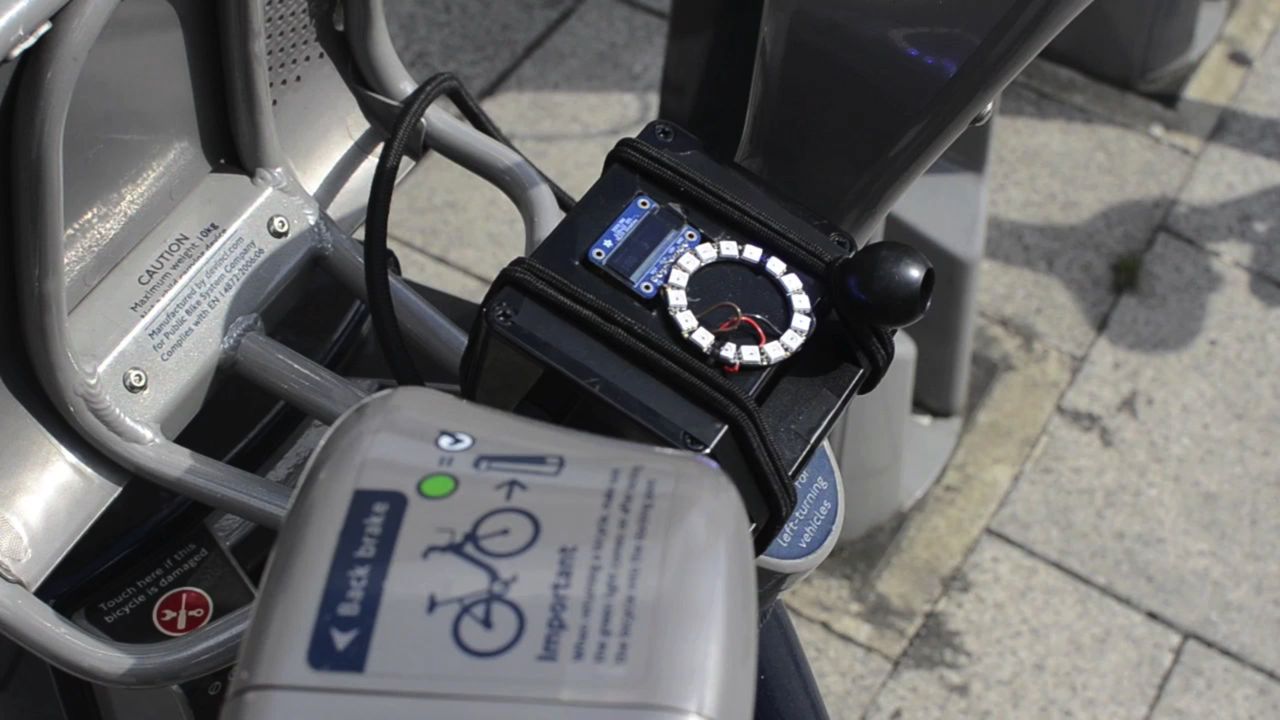
What you see here is a project box tied to a bike – but imagine it as an immutable part of the bike. Not on a phone; just a GPS, 3G modem, and a ring of lights – perhaps that tiny OLED screen – added to the Bill Of Materials of your average hire bike. As minimal as you can get.
But how radically it changes the service: how much it encourages you to use it if you don't know where docking stations are, or helps you find a spot at the busy times of the day. Manifesting the networked shadow of the hire system in the bicycle itself has changed a user's relationship with it, and their possible interactions with it.
By thinking about how objects manifest the services that underly them, or how services can manifest in objects, we start moving on to think about what the appropriate interactions with those services are. Not just "what does the user do", but "how does what the user does relate to a larger model". Do their interactions with the avatar reflect their interactions with the service?
Interaction Design is not just about designing things to interact with; it is about designing those interactions themselves.
Too often, connected products reach for the same, simple metaphors for interaction. There's a particular pair of patterns I'm a bit wary of, and I call it Big Stick and Binoculars.
Firstly, Binoculars: being able to see the control panel from further away. "I can see the controls on my phone!"
And then, once you've got your binoculars, the Big Stick: "I can push the controls from further away!"
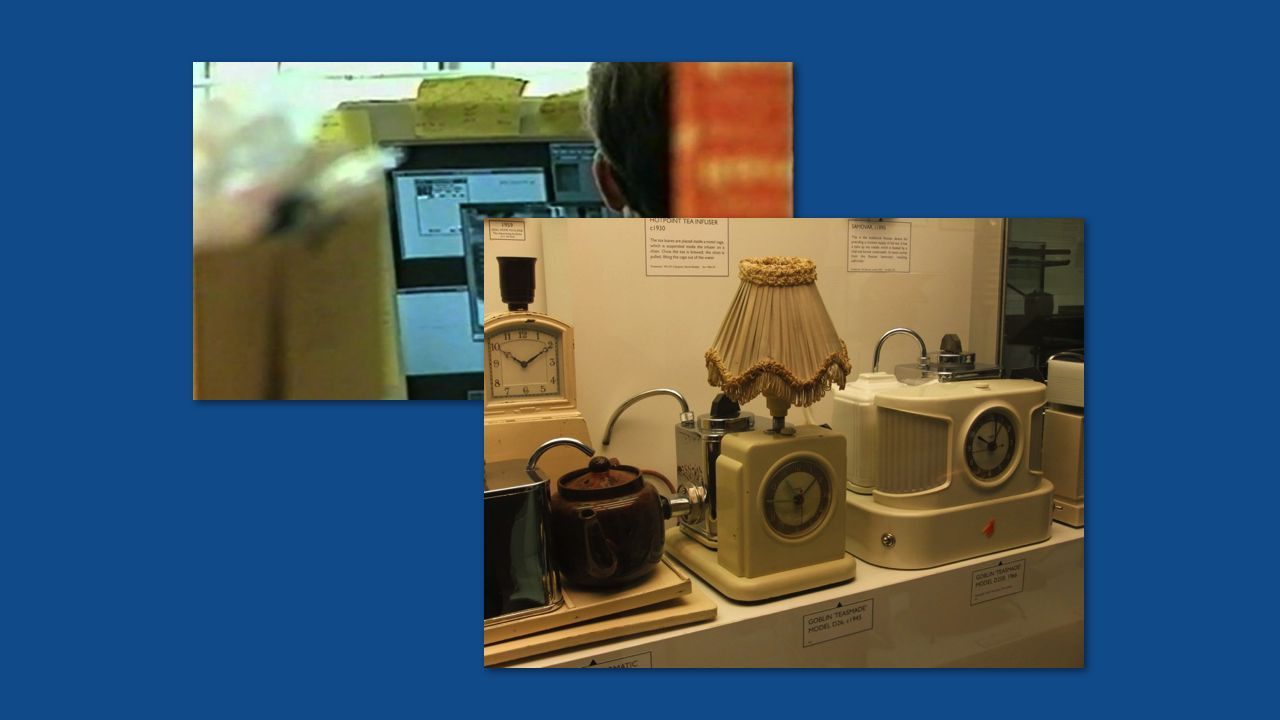
These patterns are those of two canonical smart objects. First, the Trojan Room Coffee Machine, first made in 1991: a dedicated tool (that'd later become a website) that showed a camera image, piped through a video capture card in an Acorn Archimedes, to let people know if there was coffee in the pot. The object isn't directly connected, but the interaction really is the same.
And, secondly, the Teasmade. A bedside kettle attached to an alarm clock that boils at a particular time, so you always wake up to fresh tea. First made around the turn of the 20th century, it's not connected, and it's barely smart. But: it's a big stick fired through time, to the next day. Action at a distance.
Worth saying this slowly, and clearly: neither of these are bad interactions; sometimes, they're exactly what is needed.
For some products, a Big Stick or pair of Binoculars can be surprisingly effective – not having to check to see if there's coffee, or turning the coffee on remotely, are still somewhat interesting new behaviours. There's definitely value there.
But when you're combining an object with the services it represents, entirely new interactions become possible – and perhaps the point of designing Connected Objects is the entirely new things you can do with them. What are the things that are only possible when the service, and the object, and the data, and the network are joined together?
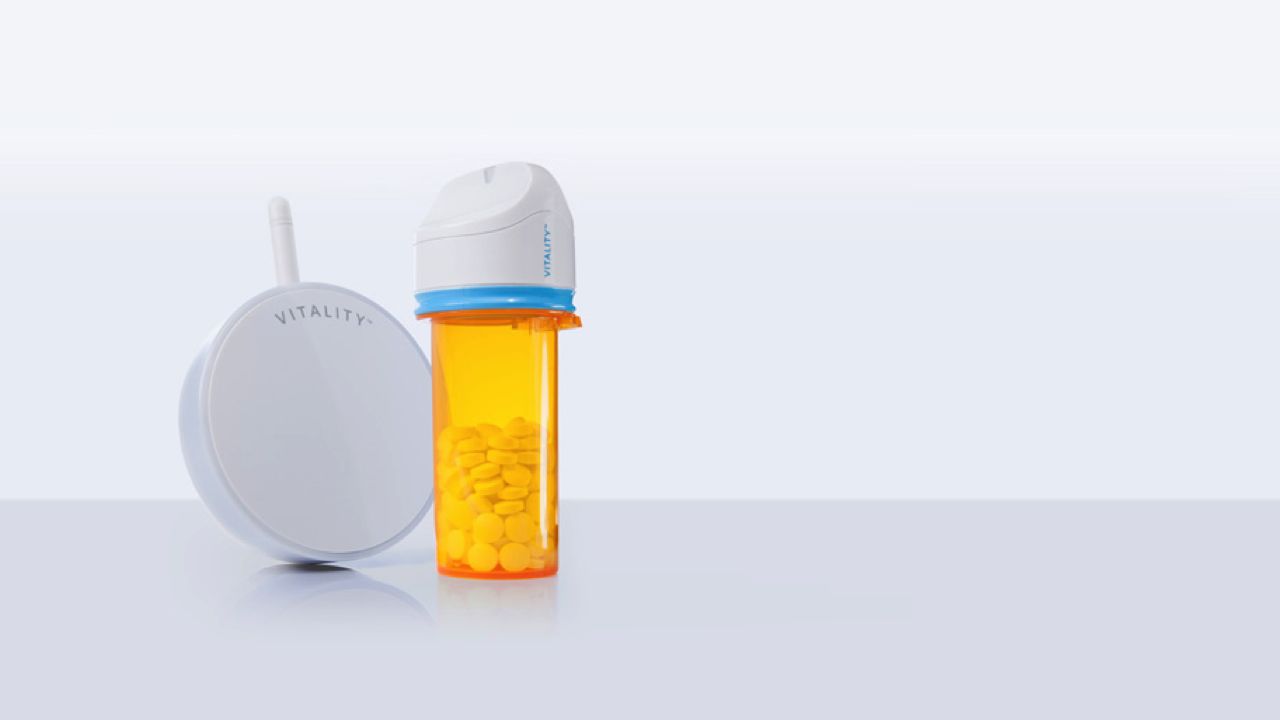
This is why artefacts like Glowcaps are so interesting – a pill bottle that reminds you when to take its medication, instantly, wirelessly.
It doesn't just replace the functionality of the safety lid but with electronics; it also hooks into the variety of systems the medication represents – refilling your prescription at a pharmacy; distributing the medication according to your specific prescription from a doctor; notifiying caregivers; integrating with insurance providers.
It's a compelling connected device precisely because its interactions go beyond Big Sticks and Binoculars and into a connected, networked realm. The problem, then, with the Big Sticks and Binoculars is not the "action at a distance" and "seeing further" aspects of them; it's taking those literally, when we also have the network available to us.
The Glowcaps bottle is connecting itself and all of these components across seams.
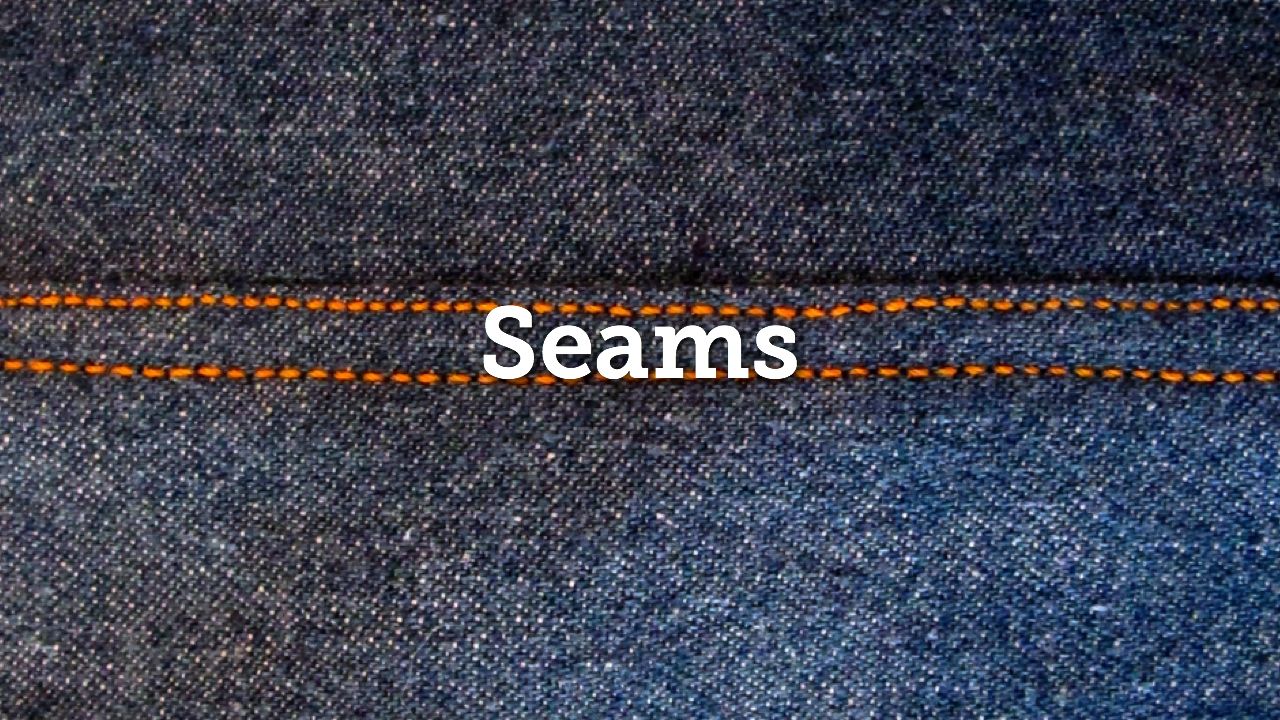
Seams: the things between things.
What sort of seams do we see in connected products? The seem between a data source and the data being logged (so, say, from performing the act of running to a fitness device measuring that act); between that device and your computer or phone (and there's a seam in terms of the software and interaction, but it's defined by another seam – radio or cable or USB); between the computer and the network; bewteen one service and another – ie, bewteen Runkeeper and your Facebook account, or between a Belkin Wemo camera and your email.
And there are seams we cross inside interactions – when we move from the public to the private, such as entering a password or other security credential; or when we move from an automated service to one where we interact with a human being.
These seams can act as speed bumps: they slow us down, remind us that there's a connection between things, that different agents are at play.
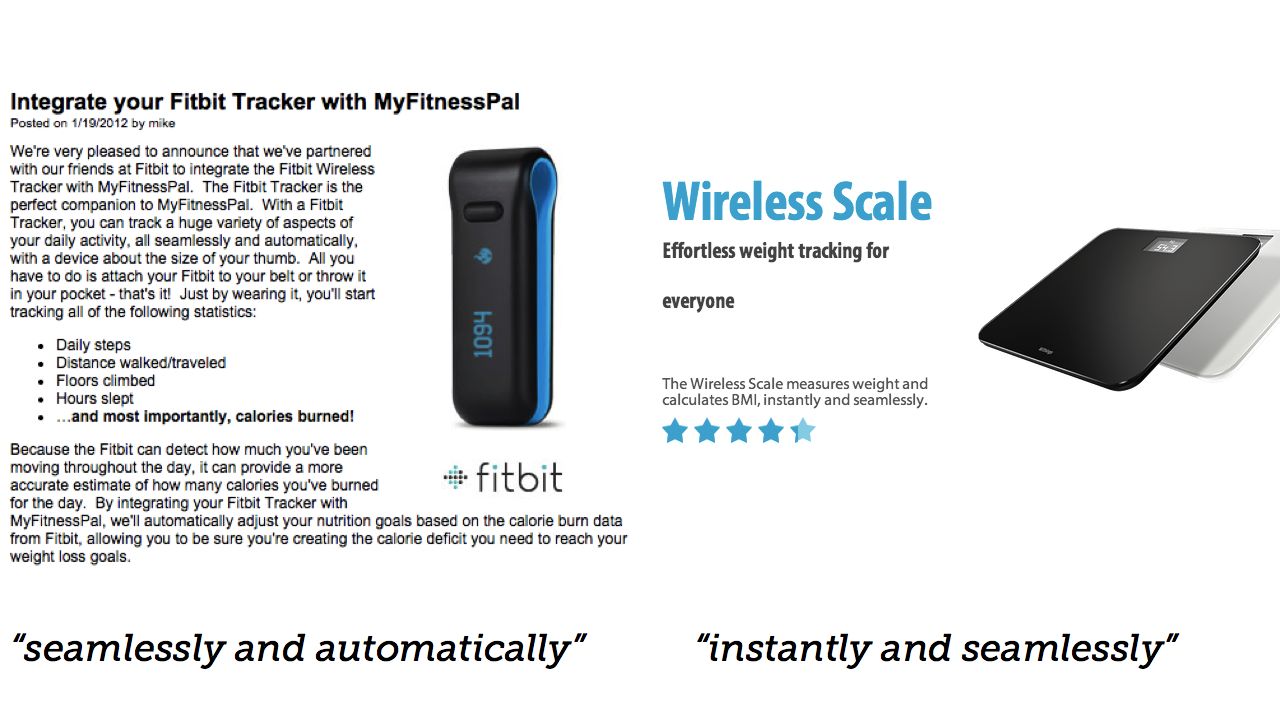
So often, connected objects promise us that they're seamless.
But this seamlessness is seductive and dangerous – because by hiding the seams, we often hide to the user where points of failure might be until it's too late.
Here's a great example.
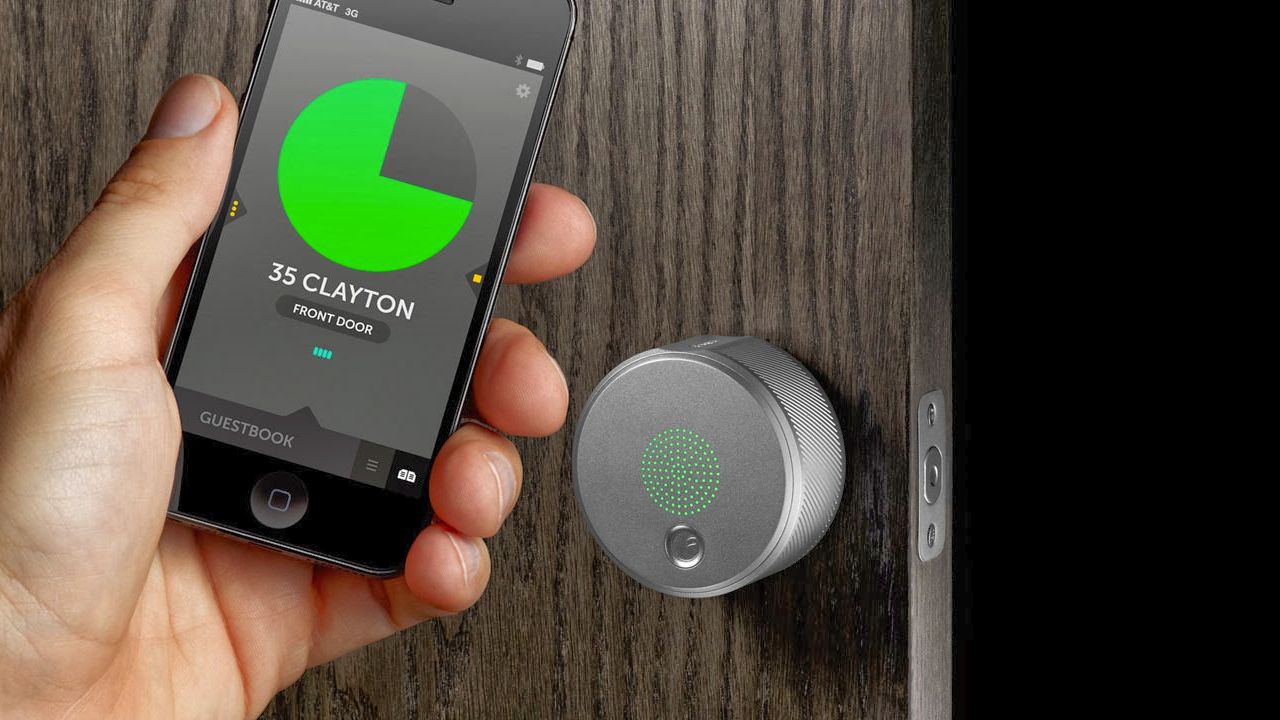
This is an August Smart Lock. It's hitting the US market right now. It attaches to the deadbolt of your house's front door lock, and can then be controlled from your phone – either directly, or also via proximity.
Techcrunch just reviewed it, and, I don't know, it didn't leave me feeling great about the product.
First, the promises of seamless, automatic entry/unlocking was thwarted by his housemates:
"...much of the utility of the lock was negated by the fact that I have roommates and not all of them were willing or able to download the app to test it out with me [...] My dream of using Auto-Unlock was stymied basically because my roommates are luddites."
Then, the promise of seamlessness was threatened by implementation:
"Every now and then it didn’t recognize my phone as I approached the door."
And so now we have a lock that can't be trusted – which comes full circle in what for me is the highlight of the review:
"There was also one late night when a stranger opened the door and walked into the house when August should have auto-locked the door."
that's mitigated in the review by the following –
"(The stranger was trying to enter our next-door neighbor’s house and didn’t realize he was at the wrong door."
– but WHAT THE HELL?
The lock failed silently and seamlessly and let somebody in.
Here's the think about locks, and doors: they are excellent seams! They are a speedbump to entering your house. They are designed to make you stop a second and prove that you have the credentials to enter. Seams are points to make decisions, choices, and actually – as a user – to be empowered, rather than ignored or assumed.
Houses last hundreds of years, if you're lucky. Locks... are pretty resilient too. But I, personally, would question trusting a consumer electronic device at the level of fidelity I do the edifice of a house.
The promises of seamlessness aren't just thwarted by implementation detail, like unwilling housemates; they can also be a dangerous abstraction. So instead of seamlessness, why not embrace the seams?
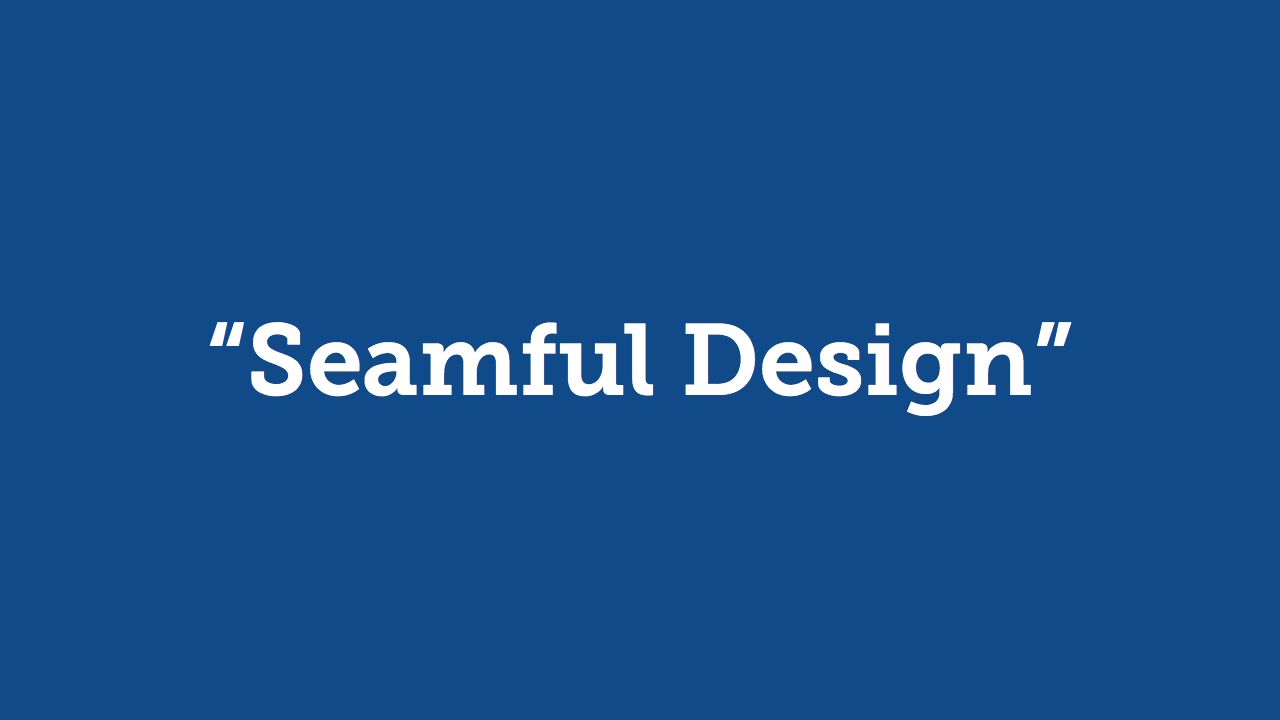
This is what Matthew Chalmers described in the context of what was then called 'ubiquitous computing' or ubicomp, as seamful design:
"Seamful design involves deliberately revealing seams to users, and taking advantage of features usually considered as negative or problematic"
And he goes on:
"Seams in interactive system designs and infrastructures show through in users’ interaction, but we can design for such seams. We can help users understand and adapt our systems and their activity, with design that weave transparent use and more analytical use together into... 'the fabric of everyday life'"
He's not advocating exposing all seams; but he is advocating exposing the meaningful ones. By exposing those, users can come to a better understanding about what's really going on in a connected object: where data transitions from one place to another, or changes state; where potential failure might lie; what they need to be aware of.
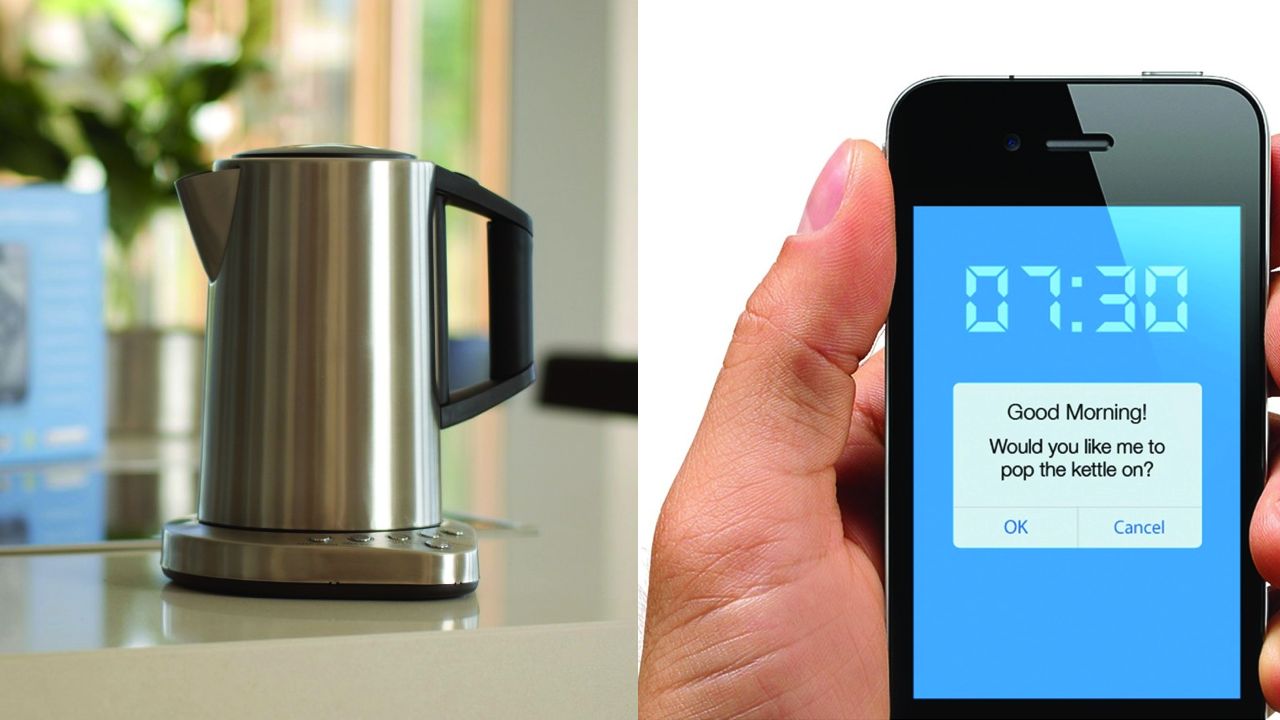
There's no bigger seam for the connected object than that between the object and all the services it connects to.
Will that service be around as long as your product? Sounds silly, especially if it's your service – but plastic and aluminium will long outlive your acquihire. Seams, after all, are traditionally points of failure. If your trousers are going to rip, we all know where that rip's likely to fall.
How long will the Maplin iKettle work? Does it have a centralised server or not? If it does, what when that goes down? If not, what when the company no longer makes iOS updates for it? At least at the end of the day you'll still have a $200 kettle that can boil water.
It can boil water without the network, right? (Yes, it can).
So what are the ways around that?. And, more to the point, how do you communicate that to the end-user, be they consumer or domain expert?
Maybe you're not running a service – maybe you're integrating with other services, like Glowcaps.
What is the ongoing life of this product going to be like?
Well: how long will they be around? Does that industry – health, say – only work that way in one territory? What about when I move house? Or emigrate? Does my seamless service cease to work, or is there a clear way to swap it out?
Seams have meaning, too. Think about the fitness space. Different services can have different meanings to their audiences – and are they all appropriate? Will some casual users be put off by a lack of a particular integration, or will they be put off by the message your existing integration list sends – that it's all, say, services for serious athletes?
Like Erin said earlier: we create things that people will spend their time on; possibly a significant quantity of time. So bear in mind that when you make something successful, people might well build their lives around your product. That's a lot of responsibility, and what are they going to do when you leave? That's not just lock-in to a particular service, it's an emotional lock-in, too.
Trust is a big thing to ask. When the service and object are this closely linked, a failure of trust in the object turns into a failure of trust in the entire service. When TFL's data breaks, it's not them I swear at; because when their data breaks, Citymapper breaks, and it's Citymapper, the third-party product and service that uses it, that I start to question.
Seams can be a place to mitigate that trust, rather than jeopardise it.
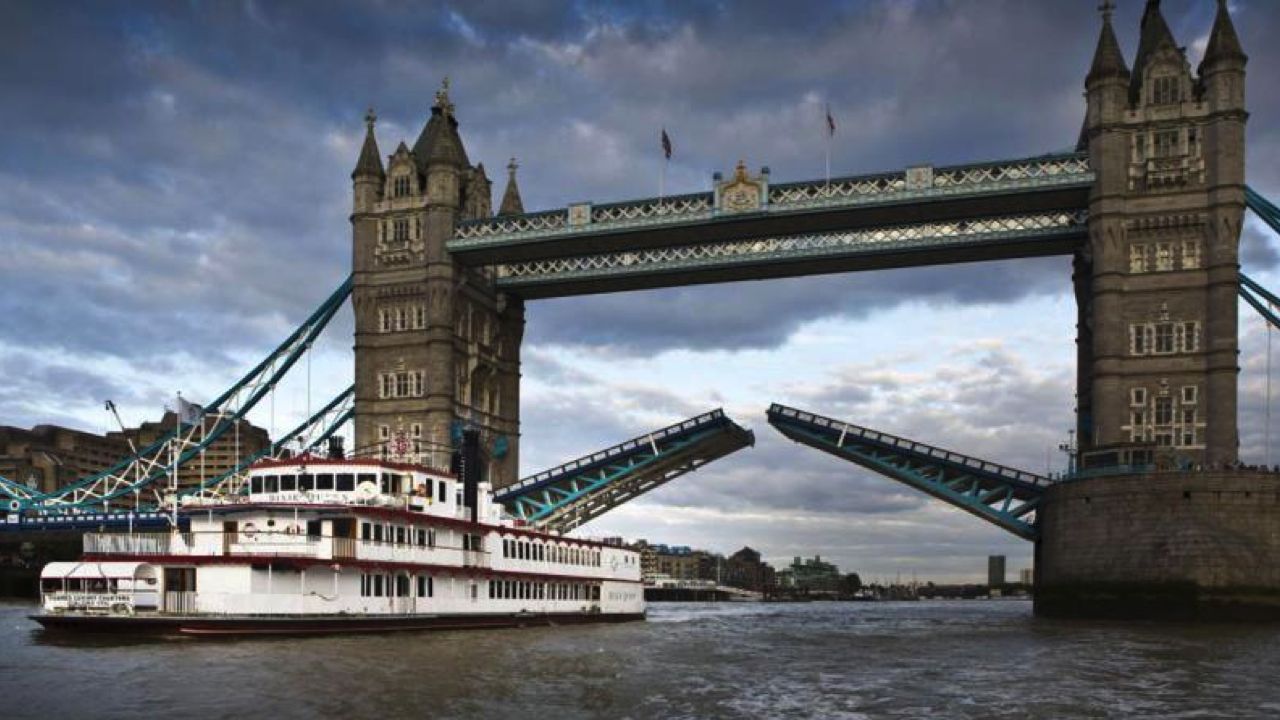
For instance, Tower Bridge has this huge seam that becomes visible when people talk to it and I reply in its voice, as a puppetmaster. They can see that the Magic Voice it talks in when spoken to is not the same as the Automatic Voice it normally has. It makes them laugh, but it also makes it clear that it speaks in two tones, and the humanity of my puppetmaster voice reminds them taht most of the time, it's not me, it really is automatic. It reminds the user that it might be useful as a side-effect, but it's also an entertaining, provocative toy; it frequently downplays its usefulness.
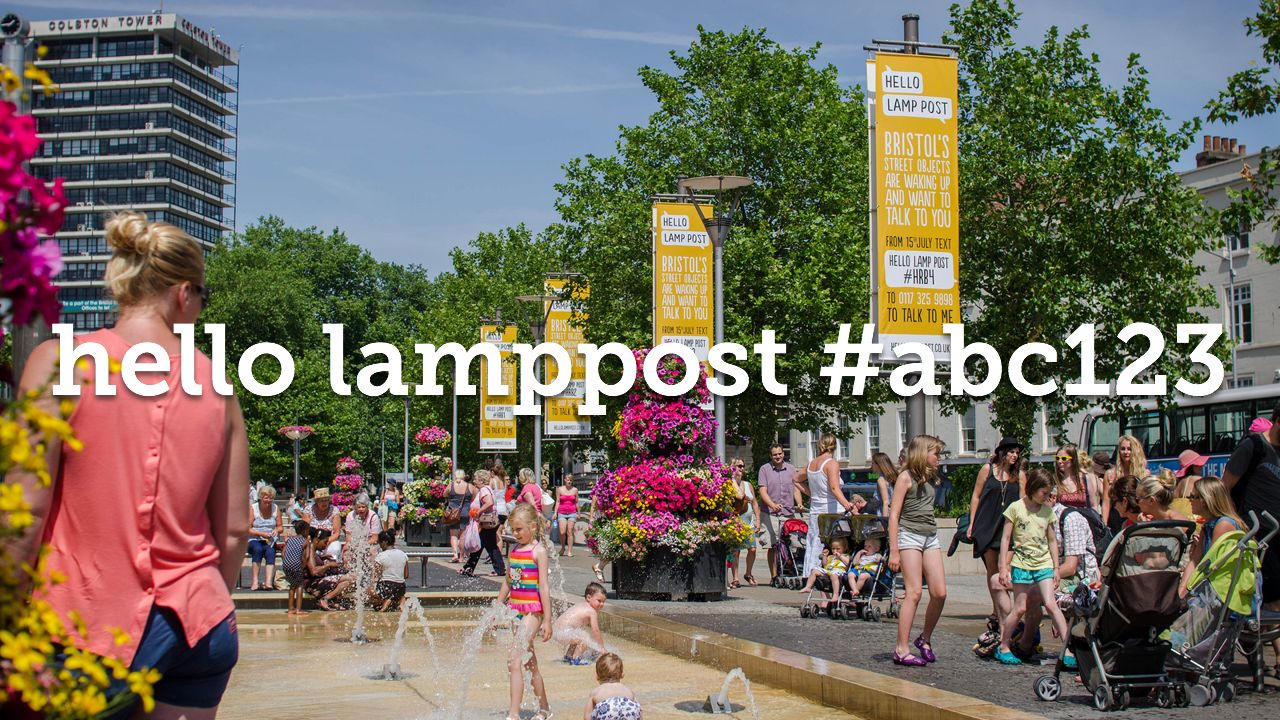
Hello Lamp Post, similarly, has a huge seam at the entry point to it. Namely: you must address it in the correct format to start conversation.
We can't hide that. (Well, we could have, but I wanted to avoid Hard Problems like natural langauge processing, so we simplified and used a convention instead). We're really explicit about it too – hence the posters with the full instructions on.
We have that big seam, but people don't mind it, becuase we tell them about it very explicitly. From that point on, they can say whatever you want – and then everything else in that interaction is very fluid and freeform. The next time they want to start a conversation, they know how to begin it – the friction is already reduced. By emphasising the boundaries and seams, we actually made the user experience better, and made the later 'magic' of the experience more effective.
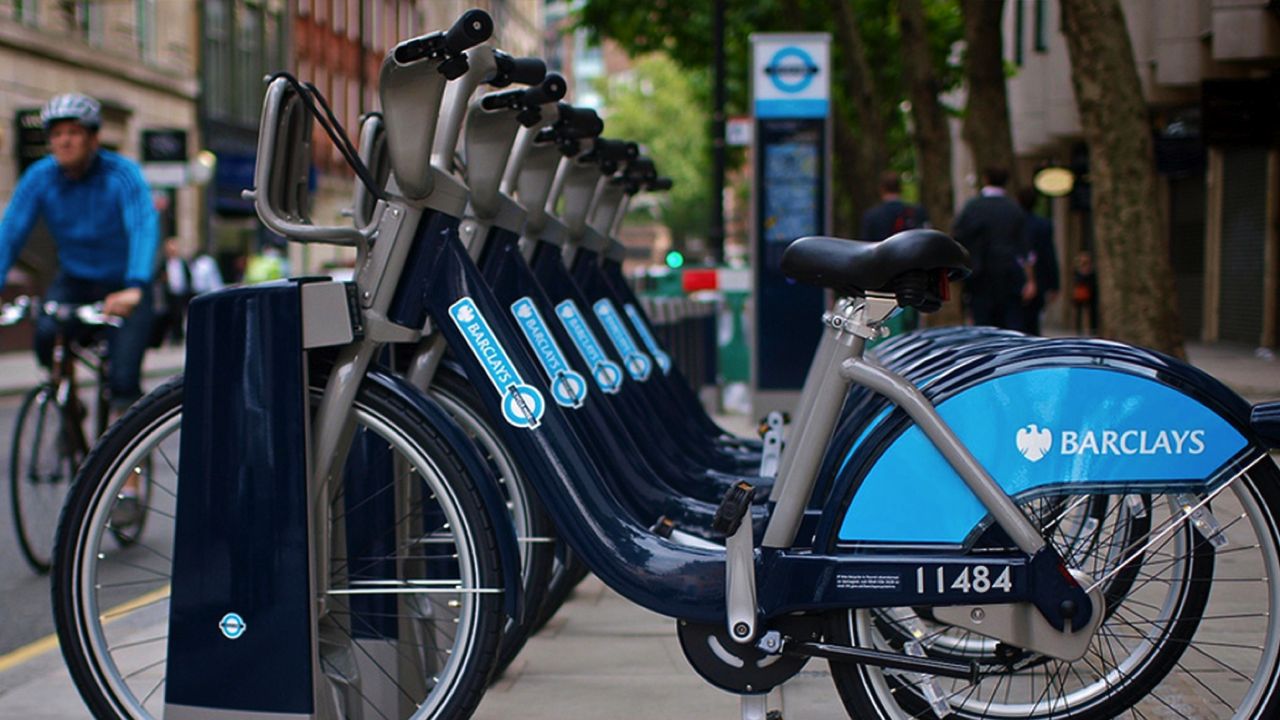
Connected objects and services in the urban environment need to be resilient to failures in the object, resilient to failures in the technology – and also resilient to failure on the part of the operator (a lack of understanding, a mistake you made). Columba is deliberately vague in order that it is wrong less often. The bus still arrives even if the timetable is broken: there is a paper timetable, there is an online service, and so forth. All the digital service is doing is offering a higher resolution of truth – the information is degraded but not lost.
Cities – and the things in them – transit, infrastructure, services – last. The default for a city, so often, is resilience.
Cities have the broadest range of possible users, and that presents the broadest range of seams, between all those different types of users and the services and objects of that city. Cities also can't abandon existing analogue interactions, of paper, and cash (though they try); they have to sit alongside the digital; services that present a variety of ways to interact and afford them all.
When done well, they make their seams really obvious – seamlessness is too much of a risk with that many unique use cases – and so the connected layer becomes evident – and not dependent on the user's devices, income, or technological competence to operate.
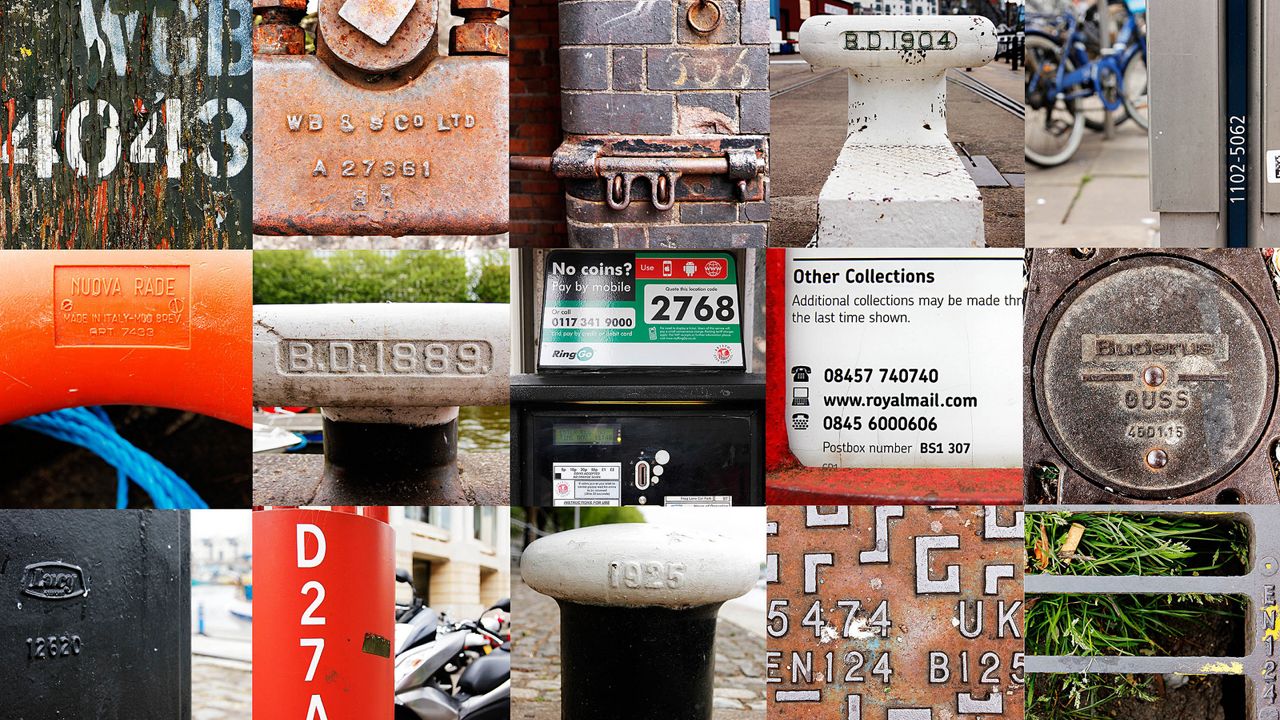
And I think this broad, resilient, approach to designing connected objects – designing for the wide use-case first, and understanding the seams throughout the product's journey – has a great deal of value in how we design products and service in general.
The cities we live in, the infrastructures we engage with; these are long-term relationships that don't orbit around what OS is running on our phone this year or what brand of trainer we wear. They affect lots of people, in lots of ways, and have to work for all them. So perhaps, even when thinking about the smallest, most personal object, why not start thinking about them from the broadest perspective; what the hundred-year lifespan feels like – what they might feel like when they acquire the tsukumogami that Matt talked about this morning.
When we're thinking about making Connected Objects, Things on the Internet, diversity and ingenuity in considering what we consider to be an Object, what might be a Thing, feels critical. Not just what objects we can most easily connect; not just Things With Wifi. Instead, things that are radically different for being connected, and that anyone can engage with; that make their seams clear.
This may be a stretch to come from what happened when we made a city talk for a few months, but I think there are many good lessons to be learned from the civic space, as I hope I've shown today, to what connected objects can be.
I think the potential for Connected Objects – for the Internet of Things – is most interesting at its broadest, most democratic and social edge. The places that happens aren't just in the homes of the affluent, but in cities and publics, spaces where objects are so often owned communally – and those objects and interactions are things we can learn from and build upon in our own practice.
Thanks.
Hello Lamppost nominated for Designs of the Year 2014
10 February 2014I’m delighted to be able to announce that Hello Lamppost, which I worked on with PAN Studio and Gyorgyi Galik as the inaugural winner of the 2013 Playable City Award, has been shortlisted in the digital category for Designs of the Year 2014.
It’s great company to be nominated amongst – Bare Conductive, Citymapper, and Oculus Rift to name a few – and we’re looking forward to showing Hello Lamppost off in the awards exhibition, from March 26. Rather exciting.
Driftwood
13 November 2013Driftwood is a talk I gave at Playark 2013. It was meant to be a talk about leftovers (the theme of the conference being 'reclaim'), and about Hello Lamp Post. In the writing, it turned into a broader overview of my own work – on six years of projects around cities and play. I was quite pleased with how it turned out, and wanted to share it on the web. (This is a roughly edited version of the script I spoke from).<p> <a href="https://vimeo.com/85435067">A video recording of the talk is also available.</a> </p></p>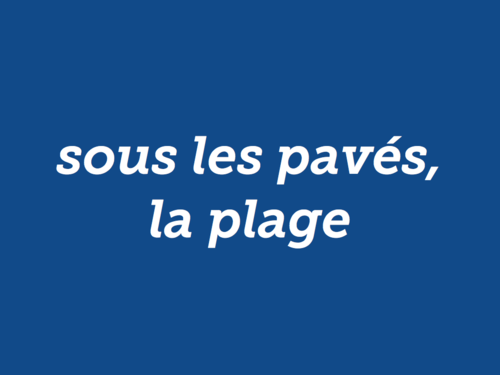
<div class="notes"> <p> One of the slogans of the Situationist International was: </p> <p> <em>sous les pavés, la plage:</em> "<em>underneath the paving slabs, the beach.</em>" </p> <p> I tend to read that as meaning something along the lines of: underneath formal infrastructure – that dictates "how to be" – is a space to be free, to play, to be unfettered. The beach is an inherently social place; a place shaped by the people on it, rather than by what it dictates they do. The institutions we erect, for good or ill, sit atop a freer environment. </p> <p> There's a lot of meaning bound up in this; it speaks to lots of things that I think are true, especially when it comes to designing toys, games, and experiences in the urban environment. </p></p> </div>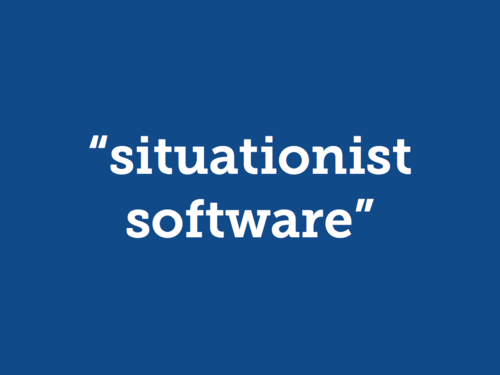
<div class="notes"> <p> I jokingly referred to a toy I was building as <em>situationist software</em> a few months ago. But now that I've had time to think about this more, situationism turns out to be a useful lens to look with. (Though, it should be noted: I am using it as a lens, not entirely literally. It contains useful ideas, but I'm definitely not embracing its entire political stance – and it is, at its heart, a political and revolutionary framework. So, you know, hoping Guy Debord won't smite me from beyond the grave.) </p> <p> Today, I'm going to draw a line through various games and toys I've built that exist within cities, looking at how they sit atop and alongside other structures or experiences. </p></p> </div>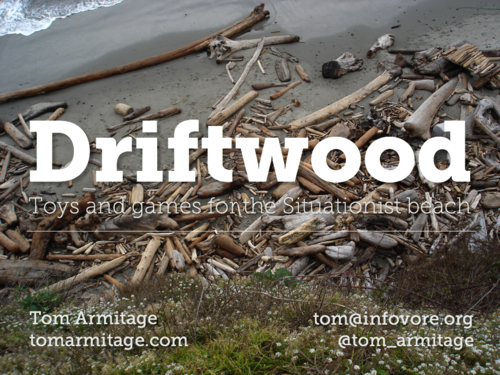
<div class="notes"> <p> Everything I'll show you has something in common. They're all built out of leftovers: leftover information, leftover infrastructure, old technology, open platforms – the driftwood that washes up on the beach of the city, and that allows us to build new experiences. I'm going to look at what driftwood – the materials we can build from – is, and how some of the ideas propounded by the Situationists help us understand the work of creating experiences for people in cities. </p> <p> The first digital toy I made that expressed some ideas about the urban environment was this: <a href="http://twitter.com/twrbrdg_itself">the Tower Bridge twitterbot.</a> </p></p> </div>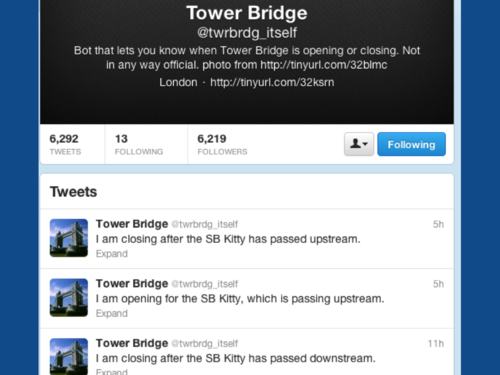
<div class="notes"> <p> I wrote this in 2008 when I worked right by Tower Bridge in London. </p> <p> It's really simple: it's a little bot on Twitter; it lets you know when the bridge is opening and closing, and for what vessel. </p> <p> It is what you might call barely-software. It's somebody else's data: all the lift times are published weeks in advance online. I just scrape the page with that data on. It's somebody else's platform – I'm just pushing text to Twitter via the API. It relies on several other people's libraries to work. It's primarily leftovers; I've written about 70 lines of code that glues it all together, and runs once a minute on a server. </p> <p> Like a lot of my work, I characterise it as a toy: a small thing that expresses one idea; partly entertainment, but not entirely so; functional, but as a byproduct of its behaviour (after all, all this information was readily available before I built this). </p> <p> But in building it – as is so often the case when you sit down to make something – it began to reveal several interesting truths. </p> <p> For starters: it's a deliberate decision to make it speak in the first person – <em>I am opening for the MV Dixie Queen, which is passing downstream.</em> Why? Because that's what you do on Twitter: you answer the question "<em>What are you doing?</em>" We all speak in first person on it; so should smart devices or buildings. Once it began speaking like us, it illustrated clearly – to me – how Twitter could be a messaging bus for more than just people, but for all the things and platforms in my life. </p> <p> By placing it into the same context as friends and other services, the Bridge told me more than just about its functionality. It became a heartbeat for the city, showing me how often it opened and closed, letting me imagine how often people sat in queues on it, or waited patiently at the large blue gate on the footpath. Even when I couldn't see it, it reminded me how the city I lived in worked. </p> <p> And as a result, not just for me, but for my friends, it became curiously evocative – not just a functional tool, but a powerfully emotive one too. When visiting family, or overseas, it reminds me that London is still there, still ticking away with mechanical precision. This little piece of software had become synecdoche for the whole city. </p></p> </div>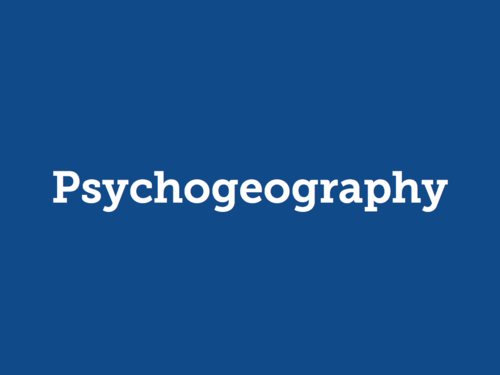
<div class="notes"> <p> It taps into what situationist Guy Debord described as <strong>psychogeography</strong> </p> <blockquote> <p> The study of the precise laws and specific effects of the geographical environment, consciously organised or not, on the emotions and behaviour of individuals. </p> </blockquote> <p> Or, more plainly: the relationship between "place" and our understanding of the world. </p> <p> I have two small toys I've built in the past couple of years that are more explicitly and deliberately psychogeographic. </p></p> </div>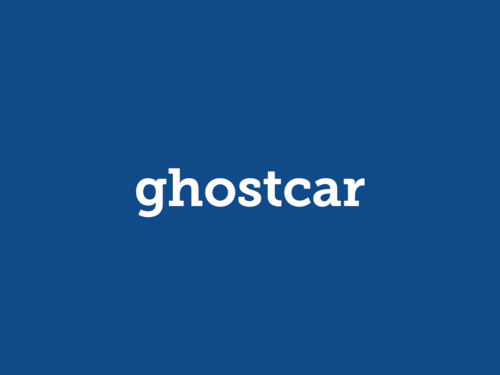
<div class="notes"> <p> <a href="http://infovore.org/archives/2012/07/30/ghostcar/">I wrote <em>Ghostcar</em> in 2012.</a> It's a toy I made in part to see how viscerally I'd react to encountering myself on Foursquare. </p></p> </div>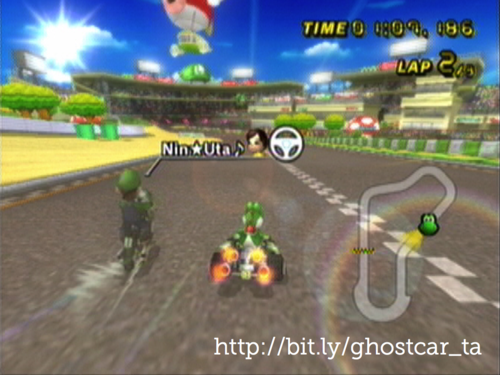
<div class="notes"> <p> It's like the ghost car in a racing game that shows you a high score – like in Mario Kart or Ridge Racer: an invisible car that represents the fastest time on the track. </p></p> </div>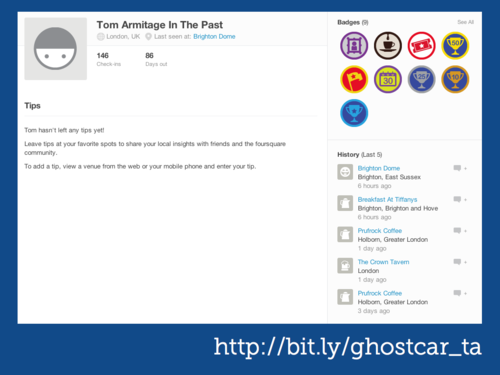
<div class="notes"> <p> By contrast, Ghostcar takes me checkins from precisely a year ago on Foursquare and echoes them onto a second, secret Foursquare account. My account is called <em>Tom Armitage In The Past</em>. </p> <p> What this means is: I can check into a location and find myself, a year ago, standing there too. Does that make sense? </p> <p> (The terms and conditions say I can't imitate other people, but that doesn't stop me imitating myself, right?) </p> <p> So there's me in the present, and also me-a-year-ago brought forward into the present. </p> <p> What I learned from this is: you can very viscerally remember a year ago. I see old-me somewhere, and remember who I was in that pub with, or why I was at an event, or what terrible film I saw, or how sad – or happy – I was at any particular point in time. </p> <p> It reminds me of how I'm attached to places; what my routines look like. And it's much more visceral to see it on a map – on the same platform I entered this data into – than to just get an email about it. </p> <p> Again, it's all made of leftovers – leftover data, that I spat into the world a year ago. (And: I started using Foursquare properly around the same time I built this, in order to fill it with good data). Somebody else's platform. Somebody else's libraries. ghostcar itself is, other than admin interface to set it up, fundamentally invisible. And once it's running, you never touch it again: it'll continue working forever. </p></p> </div>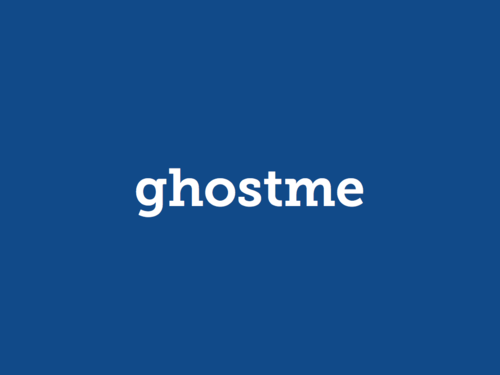
<div class="notes"> <p> And that model – virtual copies of myself used to explore weird behaviours – continues to fascinate me. So I'm making a follow-up. I've just kicked it off recently, so consider this the first time it's ever been shown. </p> <p> My new derivative of this is called <em>ghostme</em>. Ghostcar displaced me in time – a year. Ghostme displaces me in <em>space</em>. It makes a copy of me that inhabits another city, and goes where I might go were I alive there. </p> <p> Let me explain it more clearly. Once again, this is a Foursquare echo machine – we're taking the checkins from one account, and then reflecting them on another. Only this time we're being less literal. </p></p> </div>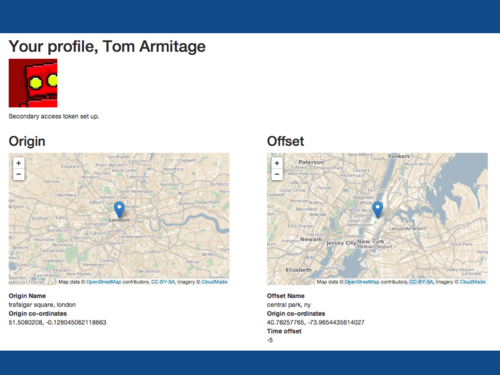
<div class="notes"> <p> When I set up Ghostme, I tell it what I think the "centre" of my existence is. I've chosen Trafalgar Square in London. I also tell it what I think the centre of my copy's existence is; in this case, Central Park in New York. </p></p> </div>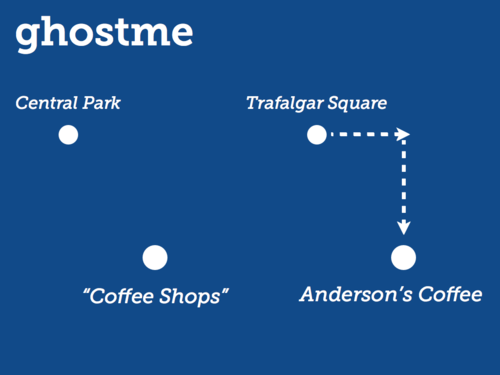
<div class="notes"> <p> Then, every time I check in on Foursquare, the software calculates that checkin's position as an offset from my centre; applies that offset to the centre of New York; and, most crucially, then looks for all the venues in NY by that location <em>in the same category on Foursquare</em>. </p></p> </div>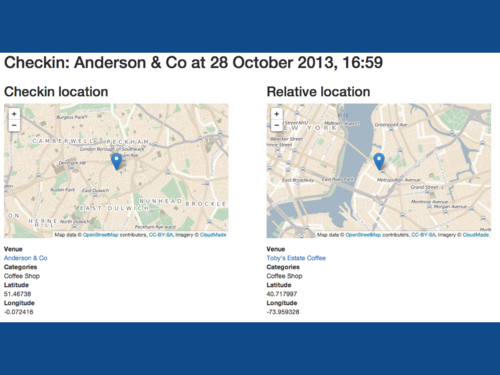
<div class="notes"> <p> So, in this case, it takes a rather nice Peckham coffee shop, and looks for a coffee shop reasonably south and east of Central Park, and finds Toby's Estate in Williamsburg. Which is a coffee shop I rather like. </p></p> </div>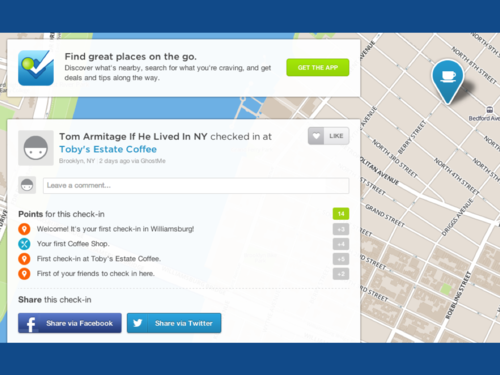
<div class="notes"> <p> And, five hours from now – because of the time difference – ghost me goes and checks in there. </p></p> </div>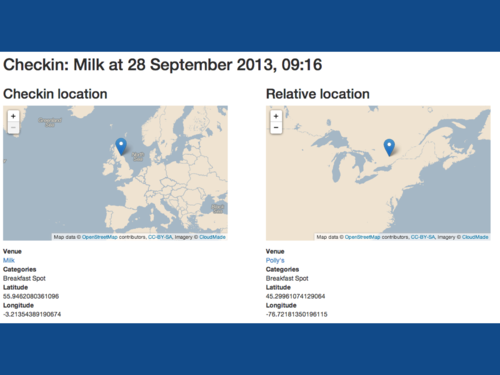
<div class="notes"> <p> I wrote and tested a lot of this in a café in Edinburgh. I kept finding parallel checkins in Ontario, which I thought was some awful bug, until I looked at a map and realised no, if you go as far north from NY as Edinburgh is from London, you get to Canada. </p> <p> It teaches you a lot about relative space, for starters; it also has weirder connotations, because it's less directly in your control – but when, in the case of Toby's Estate, my ghost copy goes to a place I've also been to – and that I love – it makes you grin; it's like affection for a pet or a child. </p> <p> It also shows you how different the population densities and shapes of cities are – NY is, broadly speaking, quite long, especially if you consider Central Park the middle (which, given the size of Brooklyn, it really isn't). And: it reminds me how much I like that city, and how much I love the one I currently live in. </p> <p> It's not been live long – and still needs polishing before I can let anyone, even friends, use it – but it's having the psychogeographic punch I wanted it to have. </p></p> </div>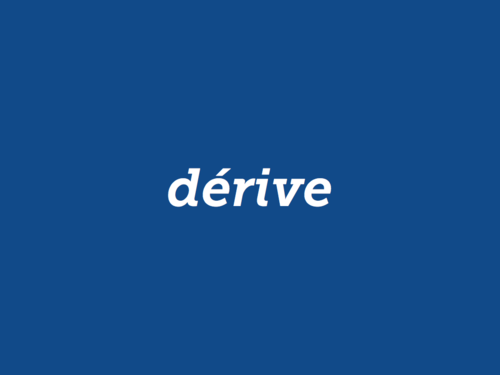
<div class="notes"> <p> I can't talk about Psychogeography and the Situationists without talking about <em>dérive</em> – "Drift" – Debord's process for experiencing the psychogeographic procedure. </p> <p> Put simply: <em>dérive</em> is an unplanned journey through the city, allowing oneself to be directed by the architecture and environment. The goal is to experience something entirely new – to expose yourself to <em>situations</em>. It is not so much getting lost as simply walking with no particular plan and being shaped by the way the environment impacts your unconscious. </p> <p> Debord would point out that it was necessary to set aside both work and leisure in order to dérive successfully – to commit wholly to the task. That is a somewhat indulgent process, I'll warrant – but I reckon it still has value at a smaller, less total scale than Debord advocated. </p> <p> An earlier project sought to alter and shift participants' relationships with the city they lived in. </p></p> </div>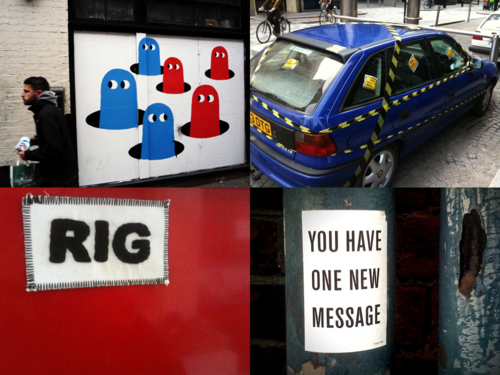
<div class="notes"> <p> My friend Tom Taylor and I, in about 2009, noticed a lot of our friends taking similar sort of photographs on Flickr – tiny things they'd noticed in the world, not sure if anyone else had seen it, captured for posterity. </p> <p> We liked that behaviour, and, more importantly, wanted to see more of it – wanted more people to look at the world like this.. So we built this tiny, almost-game, called <a href="http://noticin.gs">Noticings</a>. </p></p> </div>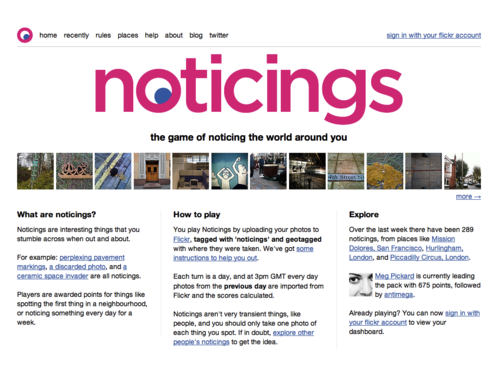
<div class="notes"> <p> We explained it at the time thus: </p> <blockquote> <p> Noticings is a game you play by going a bit slower, and having a look around you. It doesn't require you change your behaviour significantly, or interrupt your routine: you just take photographs of things that you think are interesting, or things you see. You'll get points for just noticing things, and you might get bonuses for interesting coincidences. </p> </blockquote> <p> Players played simply by telling the site they were playing, and tagging photos on Flickr as "noticings". </p> <p> When it launched, there was one rule: you get ten points for taking a picture. Each day, we'd score the previous day's photos. And as time went on, we added new rules: </p> <ul> <li> being the first person to take a picture in a neighbourhood </li> <li> your first picture in a neighbourhood</pli> <li> taking a picture of a typo </li> <li> taking a picture of something red </li> <li> taking a picture near where another picture was taken </li> <li> taking a picture every lunchtime for a week </li></ul></div> </div> <div class="slide"> <img class="slide-image" src="/talks/driftwood/img/driftwood.019.png" /></p> <div class="notes"> <p> And so on. It was a bit like Foursquare: some of the rules were secret, some not, and they emerged over time. Some ran for a short period of time. Here's a noticing that got points for being a noticing – and also for being something "lost" – an arbitrary judgment the player can make with a tag. </p></p> </div> </div> <div class="slide"> <img class="slide-image" src="/talks/driftwood/img/driftwood.020.png" /></p> <div class="notes"> <p> And here's a neighbourhood, where you could see noticings within a place. Note how the scores are calculated here. </p> <p> Noticings was played simply by posting picture to Flickr – it used their service, leftover data from players' photographs. It also used leftover <em>time</em> – fitting into players' routines, barely changing what they do – for some players, just asking them to use one new tag, and that's it. But it also then could encourage new behaviour, through new rules, through new bonuses – or simply because they'd enjoyed each others' pictures. </p></p> </div> </div> <div class="slide"> <img class="slide-image" src="/talks/driftwood/img/driftwood.021.png" /></p> <div class="notes"> <p> It also cultivated a tiny bit of dérive in the day – not wholehearted commitment, like Debord wanted; but just enough – drifting off in the middle of daily routine. Or changing routine, making pilgrimages, just in order to participate, like this player. </p> <p> It's exciting and weird that we changed people's behaviour like this. </p></p> </div> </div> <div class="slide"> <img class="slide-image" src="/talks/driftwood/img/driftwood.022.png" /></p> <div class="notes"> <p> Noticings closed about 15 months later. We didn't have time to make it better, and had both just got new jobs. We closed the game. </p> <p> But: people still use the noticings tag; our friends use it as a way of describing particular kind of looking. There's a little, lasting impact. And this was pre-Instagram. </p> <p> Yes, for many people, Instagram is a social camera, but look at how some people use it as this tiny little social Martin-Parr-app. Lots of people are noticing, even without our little game. What was most important was that people performed the act – not that they got points for it. The fact they still are, in different ways, makes me happy. </p></p> </div> </div> <div class="slide"> <img class="slide-image" src="/talks/driftwood/img/driftwood.023.png" /></p> <div class="notes"> <p> It's interesting for me to look back on this body of work when considering the final – and perhaps largest – project I'd like to talk about today. It takes a lot of these impulses – the psychogeographic; the act of creating situations; the act of dérive; the use of leftovers; the barely-game – and pieces them together to create a new kind of interaction that played out in the city. </p></p> </div> </div> <div class="slide"> <img class="slide-image" src="/talks/driftwood/img/driftwood.024.png" /></p> <div class="notes"> <p> <a href="http://hellolamppost.co.uk">Hello Lamp Post</a> was a project I built along with PAN Studio and Gyorgy Galik. We entered it as a pitch for <a href="http://www.watershed.co.uk/playablecity/">the inaugural Playable City competition,</a> organised by Watershed, the Bristol arts organisation – and we won. It ran this summer for two months, and, as I look back, touches on all these ideas I've mentioned so far. Let me go in to a bit more detail. </p></p> </div> </div> <div class="slide"> <img class="slide-image" src="/talks/driftwood/img/driftwood.025.png" /></p> <div class="notes"> <p> Watershed defined a Playable City as: </p> <blockquote> <p> "…a city where people, hospitality and openness are key, enabling its residents and visitors to reconfigure and rewrite its services, places and stories. It is a place where there is permission to be playful in public." </p> </blockquote> <p> It's a city built on the beach, not the paving stones. This is human, playful, gentle; very much the opposite of ideals about clarity, accuracy, integration, efficiency and refinement – all ideals that emerge in the prevailing rhetoric around "Smart Cities". </p> <p> Worth noting, too, that the Situationists were in part resistant of the Planned City – Haussman's rearchitecting of Paris in the 19th century was very much a top-down plan. He planted fully grown trees onto Boulevard Haussman rather than letting them grow – so that everything would fit the plan. But cities are made of people, and people cannot be planned; cities require space to be organic and grow. Another harking back to the situationists. </p></p> </div> </div> <div class="slide"> <img class="slide-image" src="/talks/driftwood/img/driftwood.026.png" /></p> <div class="notes"> <p> Anyhow. Hello Lamp Post. When we were developing ideas, a core theme kept emerging – memory and its relationship with location. We kept coming back to the idea of the city as a physical diary, based on the way that returning to places could help trigger memories. We wanted other people to see the city in this way, and be encouraged to share their past experiences and stories with each other. Making psychogeography a little more visible. </p> <p> And we wanted to do that in as accessible a way as possible: for the most people, at the largest scale. I've worked around ARG-like things before, and to be honest: it's not that hard to create a cool experience for a few hundred people that's not very good value for money. Making something fun and immediate for thousands – that's far harder. But if we were to make the city playable, it had to be at the biggest scale possible. </p> <p> Firstly, that meant making it super-accessible. An app for a smartphone might be cool and have GPS and that, but it limits your audience. Everybody understands SMS – <em>every</em> mobile phone has SMS – and it's super-simple to implement now; <a href="http://twilio.com">Twilio</a> does the legwork for us. Superficially unexciting technology made super-simple by web-based services. </p></p> </div> </div> <div class="slide"> <img class="slide-image" src="/talks/driftwood/img/driftwood.027.png" /></p> <div class="notes"> <p> And secondly, to use as much of the city as possible without incurring too many costs – we'd need to use things that were already there. We wanted instead to find a way of hijacking the existing infrastructure – we spent a lot of time scouring the city for opportunities. We noticed that a lot of street furniture – lampposts, postboxes, bus stops, cranes, bridges – have unique reference/ maintenance labels. We thought it would be interesting for these objects to be intervention points – something more tangible than GPS and quite commonplace. Just telling us where you are. </p> <p> At the time, I jokingly said that the Smart City uses technology and systems to work out what its citizens are doing, and the Playable City would just ask you how you are. </p> <p> What we ended up with was a playful experience where you could text message street furniture, hold a dialogue with it, and find out what other people had been saying. </p></p> </div> </div> <div class="slide"> <img class="slide-image" src="/talks/driftwood/img/driftwood.029.png" /></p> <div class="notes"> <p> This is what a conversation looks like. </p> <p> We heavily "front-loaded" the experience – the first experience of Hello Lamp Post has to be <em>really good</em>. It's no good putting all the best content behind hours of play – most of it won't get seen, as a result. So we chose to make the early interactions completely fully-featured – and then treat the players who continued to engage, to come back again and again, to more subtle shifts in behaviour that were still rewarding – but that didn't hide most of the functionality from casual players. The Playable City had to be playable by everyone. </p> <p> If a player played more, the game changes with them. The first time someone interacted with an object would be a bit small-talky – questions about the surroundings. But on return visits the object would appear to remember the player and ask progressively more personal questions – about their memories and points of view. The intensity grew as familiarity grew – and provided incentive to continue talking to objects. </p> <p> We were building a little <em>situation</em> – creating a ritual, about talking to street furniture. A friend would tell me every time he saw somebody get out their phone and clearly start texting an object; it made me happy that we'd create this new, strange little interaction. </p></p> </div> </div> <div class="slide"> <img class="slide-image" src="/talks/driftwood/img/driftwood.030.png" /></p> <div class="notes"> <p> To induct people into the idea, though, we needed to make it legible – it's a fundamentally invisible system otherwise. Watershed helped us with the physical advertising campaign. These were our hero objects: all these banners told you how to talk to whatever they were on, giving you the entire instructions on the poster. "<strong>Text hello banner #code to number</strong>". It was super-satisfying that the posters could all be the entire user manual for the game: you just do what they said, and off you go. </p> <p> The majority of players interacted with these objects first – but many would then go on to play with other objects in the city, once they'd understood it. It helped give the invisible system form. </p></p> </div> </div> <div class="slide"> <img class="slide-image" src="/talks/driftwood/img/driftwood.031.png" /></p> <div class="notes"> <p> We had just under 4000 players over the two month run, who collectively engaged in over 9500 conversations -speaking with over 1000 unique objects and ultimately sending 25000 messages our way. </p> <p> You can see the distribution of conversations – the eponymous lampposts received a lot of attention, but so did the clearly labelled post-boxes and some of Bristols icons – such as Pero's Bridge and the cranes in the old harbour district. </p> <p> Also, Gromit – from Wallace & Gromit got quite a few mentions – there were 80 giant Gromit statues all over Bristol during the summer, and people took it upon themselves to start talking to these too. Even though, you know, Gromit never says anything. </p></p> </div> </div> <div class="slide"> <img class="slide-image" src="/talks/driftwood/img/driftwood.032.png" /></p> <div class="notes"> <p> But what was most exciting was exactly *what* people were saying; what they were sharing about their particular Bristol with others; what those moments of ritual were creating. From the poetic to the local, and the personal . And of course, because of the way the game worked, other people answering questions would see these via their phones. </p> <p> And of course, the apt questions for particular objects led to particularly great answers. </p></p> </div> </div> <div class="slide"> <img class="slide-image" src="/talks/driftwood/img/driftwood.033.png" /></p> <div class="notes"> <p> As people played, we displayed their quotations – moderated, of course – on the project website. What was great was to see just how people were engaging with the city: the kind quotations we were getting from the get go was exactly what we hoped people would say. </p> <p> Now that I look back on it, I can see that Hello Lamp Post acts as a lovely summation of five years of toys and games built around cities. It's an experience that doesn't so much interrupt your experience of the city as it <em>layers on top of it</em>, letting you see the paving and the beach all at once. It builds ritual and new interactions into routine. It requires almost nothing to engage with it – and most of the systems it uses – SMS, Twilio, the city – are already built by other people. We just built the middle layer. (Which, in this case, is rather complex. But you get the picture.) </p> <p> What can we learn from all this? </p></p> </div> </div> <div class="slide"> <img class="slide-image" src="/talks/driftwood/img/driftwood.034.png" /></p> <div class="notes"> <p> By building on top of other services, we also create a kind of sustainability. When Noticings closed, the photos were still on Flickr – just with an unusual tag. If the ghostbots break, their activity is still preserved forever. </p> <p> We don't destroy the value we've created the second we turn it off. Which is more like how a city behaves: it degrades, or is reused, or gentrified, but history becomes another layer of patina on top of it – it isn't torn down instantly. </p> <p> We're not planting fully grown trees and then tearing them out: we're building an ecosystem, and perhaps other games or tools will build on top of <em>us</em>. We hoped – once people twigged how Hello Lamp Post worked – they might start drawing codes on things, on posters, on street art, in order to attach messages to it. </p></p> </div> </div> <div class="slide"> <img class="slide-image" src="/talks/driftwood/img/driftwood.035.png" /></p> <div class="notes"> <p> If the city is a beach, it is littered in driftwood. When I think of driftwood, I think about flotsam and jetsam. Flotsam is that which floats ashore of its own accord; jetsam is that which is deliberately thrown overboard from a boat – man-made detritus, as opposed to natural wastage (or wreckage). </p> <p> I think those two categories also apply to the materials I'm terming "driftwood" today. And I genuinely believe the things I'm about to describe are materials, just like wood or steel. That might be obvious with regards to some of these – but not all. If a material is something we manipulate and shape as designers, then all these things could be considered materials. </p></p> </div> </div> <div class="slide"> <img class="slide-image" src="/talks/driftwood/img/driftwood.036.png" /></p> <div class="notes"> <p> Leftover infrastructures – services like Twitter and Foursquare, more tactile infrastructure like transit networks or maintenance codes on objects. And leftover technologies, too; print-on-demand, SMS, telephony – all are now available over straightforward web APIs. These things have become commoditised and tossed overboard, made available to all. </p> <p> In this way, we can spend our time working on unique experiences and interactions, rather than the underlying platforms. </p></p> </div> </div> <div class="slide"> <img class="slide-image" src="/talks/driftwood/img/driftwood.037.png" /></p> <div class="notes"> If that's our jetsam, what's the flotsam – the stuff just floating around?</p> <p> <b>Data</b> </p> <p> The city is drowning in data. </p> <p> I tend to describe data as an exhaust: you give it off whether you like it or not, and it follows you around like a cloud. People give it off; machines give it off; systems give it off. Given all the data we emit by choice – our locations stored in Foursquare, or Twitter, or Facebook; our event attendance tracked by Lanyrd and Eventbrite; as well as that we emit regardless of whether we want to – discount card usage; travelcard usage; online purchasing data – well, what are the experienes you could build around that? This is all there (with end-users permission) for the taking, and it can lead to unusual new ambient interactions. </p> <p> <strong>Environments</strong> </p> <p> What are the environments you can repurpose? Not just the City as a whole but smaller spaces – institutions, establishments, public spaces, parks, transit networks. All these are spaces and contexts to build within, and they all come with their own affordances. Even when they're controlled or marshalled by others, they are spaces to consider reclaiming and repurposing. </p> <p> <strong>Routine</strong> </p> <p> And just as we can reclaim space, consider Time as a material to be reclaimed to: what are the points of the day we can design for – not just active, 100% concentration, but all the elements where there is surplus attention? We can't create Debord's focused, committed dérive – but how can we create a tiny fragment of it, without invading the daily routines we all have to live with? </p></p> </div> </div> <div class="slide"> <img class="slide-image" src="/talks/driftwood/img/driftwood.038.png" /></p> <div class="notes"> <p> Because ultimately, this [above] is not the city I know. This is not More London; this is Less London. More London is this big bit of space on the South Bank by city hall, which looks like public space but is, in fact, very much not. You know it's not public because it stops you behaving like it's a city; it is doing everything in its power to resist the beach underneath. </p> <p> I don't think, ultimately, the city <em>can</em> resist the beach it sits upon. There are so many things we can build atop it, be it on semi-public, semi-private, corporate spaces – or the genuine publics of the city. </p> <p> To build and make them, we don't even need to invent architectures and infrastructures – we don't even have to make it obvious they're happening. We can use what's already there – </p></p> </div> </div> <div class="slide"> <img class="slide-image" src="/talks/driftwood/img/driftwood.039.png" /></p> <div class="notes"> <p> – making new experiences out of the driftwood that lives in the city and across the network. Lifting up the paving slabs to reveal the beach underneath. </p></p> </div> </div> <div class="slide"> <img class="slide-image" src="/talks/driftwood/img/driftwood.040.png" /></p> <div class="notes"> <p> Thanks very much. </p></p> </div> </div></div>Week 45
2 September 2013A short week, owing to the summer Bank Holiday on Monday.
I’m pretty firm about doing everything in my power, as a freelancer, to take bank holidays and the like. Yes, it’s a Monday like any other. But it’s also time when many of my friends are off, and it’s good to be in sync with the rest of the world. And they have value for yourself, as well; not just enforced time off, but a space to see what your brain looks like outside work. Michael Lopp touched on this in his excellent post about the nature of work this week:
This is why vacations are essential. They hold up the mirror and show how much energy you’re spending simply to achieve baseline steady state in your day.
It’s useful to be reminded where my head is. It turns out that the answer is: running a little hot. Work progresses well, but right now it tends to involve a million tiny tasks. Those tasks are often completed quickly, but they weigh heavy until they are. There’s a high cost of motion at the moment, but it comes down as I tick things off – and lists are helping a lot.
My main focus in week 45 is Sore. I went down to Brighton on Wednesday to demonstrate it, which went very well, and opened up discussion about its final exhibition. It also set up the work for the rest of the week – bits of work on the public website, and more materials to be acquired for the installation.
I note this week that Watershed have released their own film about Hello Lamppost; it’s a nice summary of the project, and some of our thinking behind it. (It also contains the only handheld tracking shot of me hammering at code to date. Yes, I really do hit the keyboard that hard, as any former office mates will tell you.)
Next week sees continued progress on Sore, which I’ll be giving an early preview of at Improving Reality. I’ll also be down in Brighton for dConstruct, so if you’re around and want to talk, do say hi.
Week 39
16 July 2013Weeknotes are a day late this week – and for good reason.
I spent Week 39 working on Hello Lamp Post – Monday to Wednesday from the studio in Shoreditch, and then decamping to Watershed on Thursday until the beginning of this week to launch the project into the world.
Needless to say, a busy week: lots of features to be wrapped up, content to be refined, and plussing to be done. We hammered our way through the project until well into Saturday night, but come the launch event on Sunday, it was in good shape.
I will be entirely honest: I find launches hard, and do my absolute best to avoid “crunch”: it really doesn’t suit the way I work; long nights tend to introduce as many bugs as I fix. Thankfully, we had a relatively sane launch week (as these things go): lots of teamwork, some late nights working away, lots of eating well, and watching the sun go down from the Arnolfini fairly regularly.
There were, of course, hairy moments (most notably, a strange set of eigenbugs that were solved with the discovery that
twilio-rubyisn’t threadsafe). But it all came off in the end. And I’m especially pleased with how effective the final week was: there’s a great deal to be said for getting the team in a single location, with only one thing on our minds. In that final haul, we really moved the project on a lot, and could tell we had something on our hands when we sat playing with it on Saturday night, all chuckling at what was happening in our hands as if it was something alive, and not something we’d made.I’d primarily been focusing on the technology of the project in that final week, but there’s so much more to it than just the code. There’s the content within the experience; all the marketing and advertising; the graphic branding that’s permeated Bristol; the PR efforts; the beautiful models we’re using as an installation to promote the project; all manner of little details, all of which have come together.
When you’re in the middle of it all, it’s hard to see the whole; I always find that especially hard. I went to the launch party still a bit nervous, waiting for the emails from Exceptional, the people darting up to me with bugs.
And none of that happened. What happened was: people had fun. They surprised us. They told the objects storied, they laughed at the jokes, they were surprised by what one another had said. We drank champagne on College Green, and all was right with the world. By 4pm, I was out of the project-mines, and back in the world, and I could see what we’d made. It was pretty good.
All of which is a long-winded but personal way of saying what launches feel like for me, especially launches of creative works. When you’re in the mine, it’s hard to have any perspective. It’s very satisfying to see the view I got on Sunday when I came out. Thanks to Ben, Gyorgyi, and Sam, the rest of the core Hello Lamp Post team; to Clare, Verity, and all at Watershed; to Justin, our helping hands throughout that final week; and to all the collaborators throughout the project. I’ll write more about it formally soon, but in the context of weeknotes, it’s still important to say these things.
Week 39, then: Hello Lamp Post finally released into the world, advertised to a city, and already surprising and delighting us. It’s a privilege to have the opportunity to make such work, and – as I often say – to make the world a little more weird.
Hello Lamppost on the Guardian Gamesblog
28 June 2013Just a quick note to highlight the interview with Keith Stuart over at the Guardian Gamesblog that Ben and I conducted about Hello Lamppost.
We’ve spoken about it loosely to a lot of people, and there’s been a lot of high-level press doing the rounds – excitingly – but it was great to be able to go into a bit more depth about our influences and approach, and how the Playable City relates (or not) to the Smart City. It was also great to be able to cite the peers and friends that have influenced the project more explicitly.
Hello Lamppost Trailer
19 June 2013Hello Lamppost launches in just under a month. This is the trailer we shot in Bristol a few weeks ago for the project.